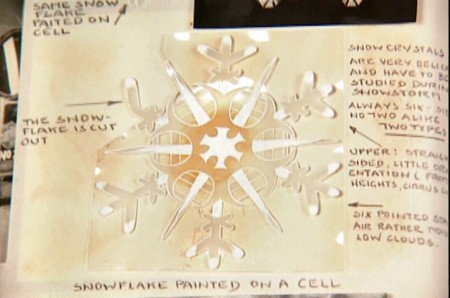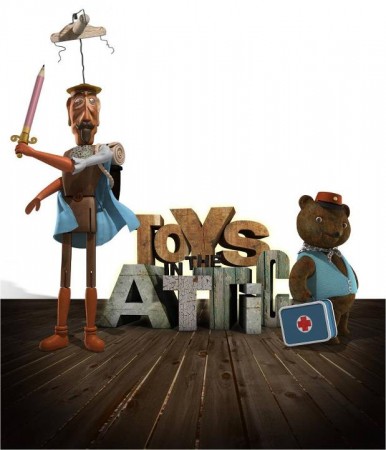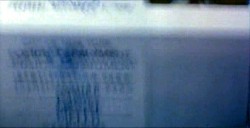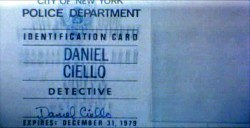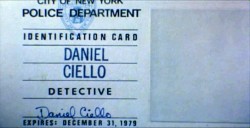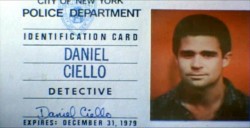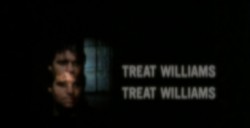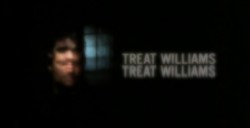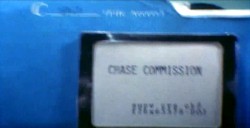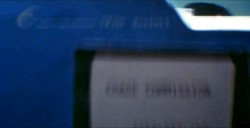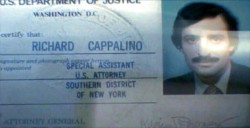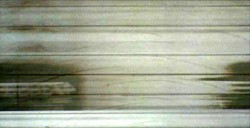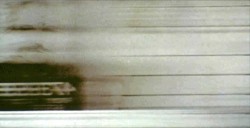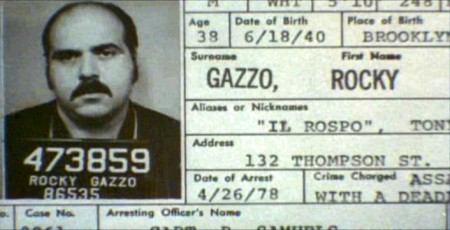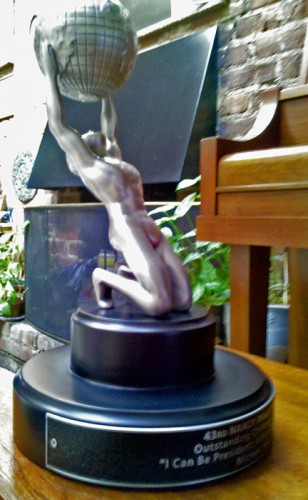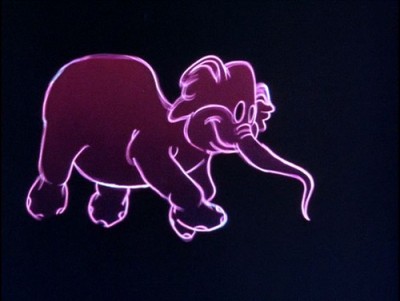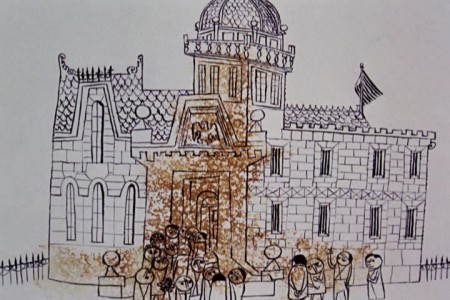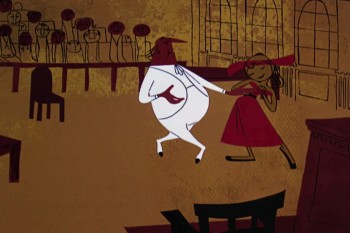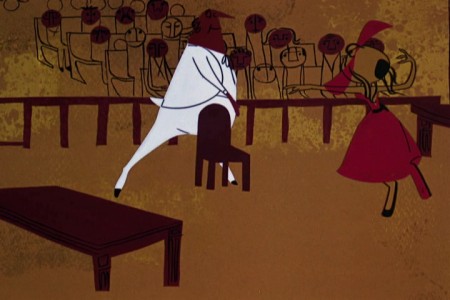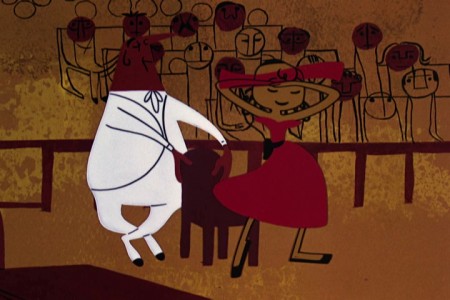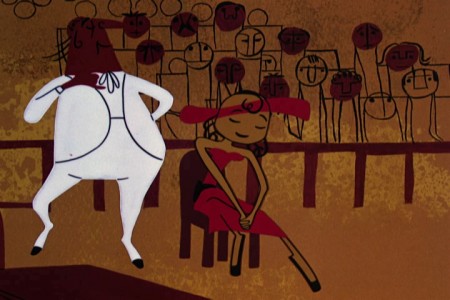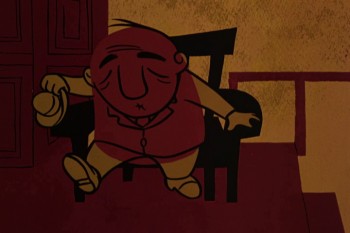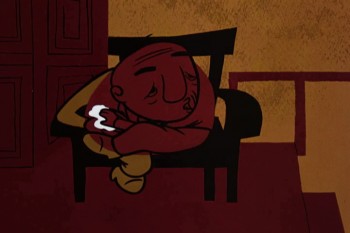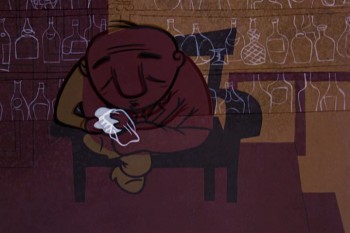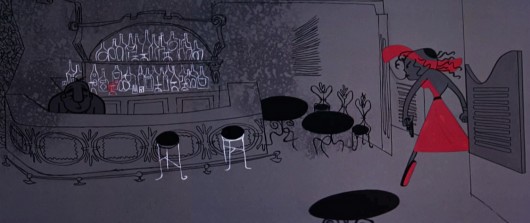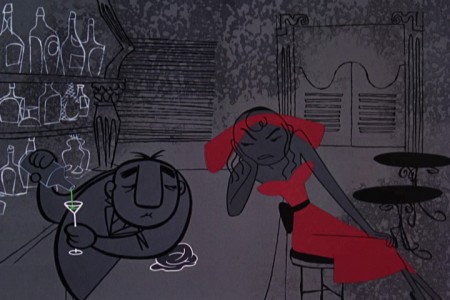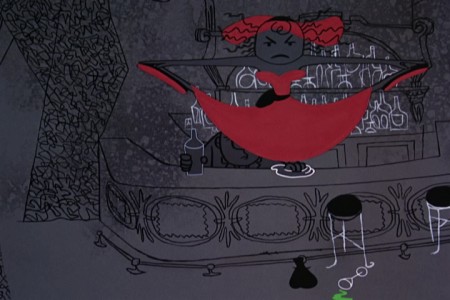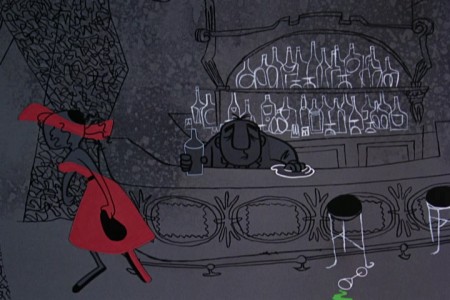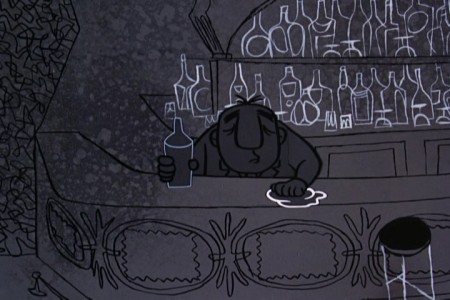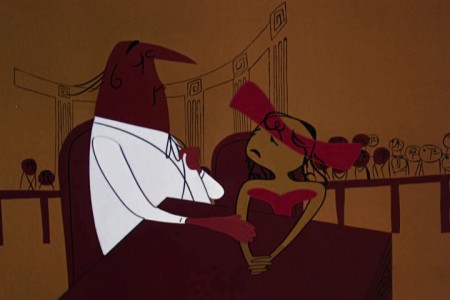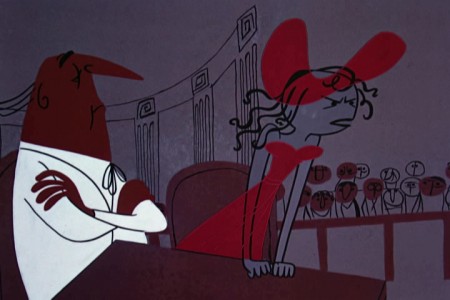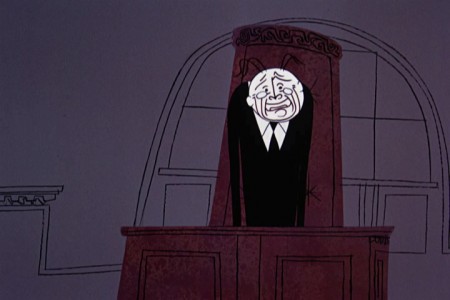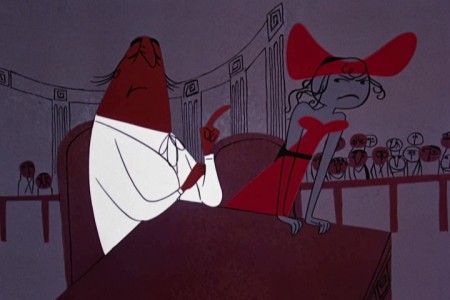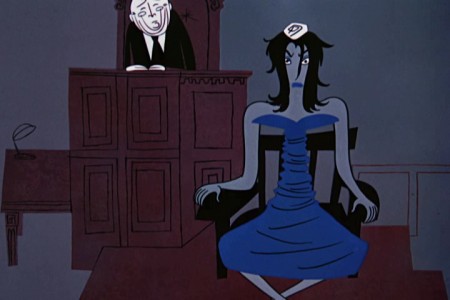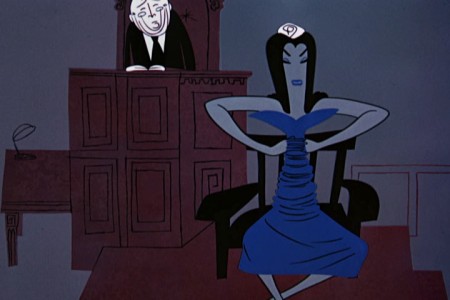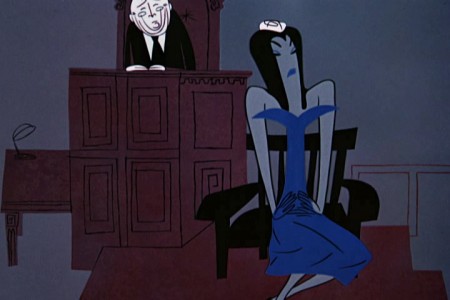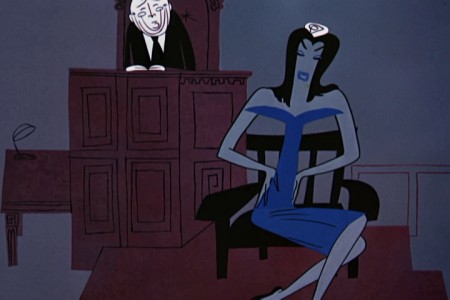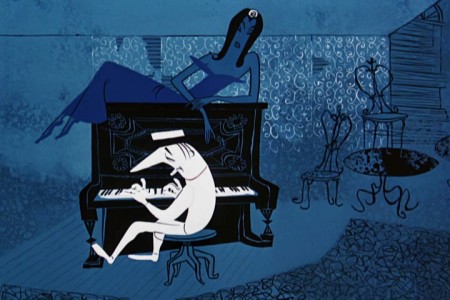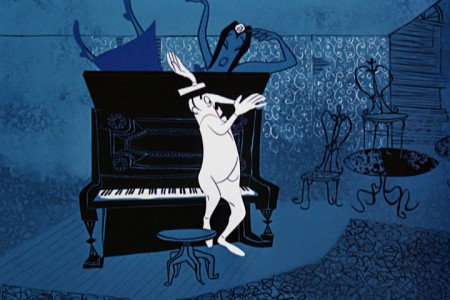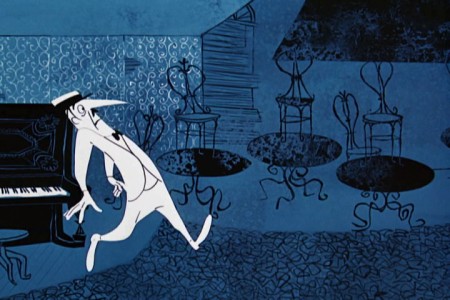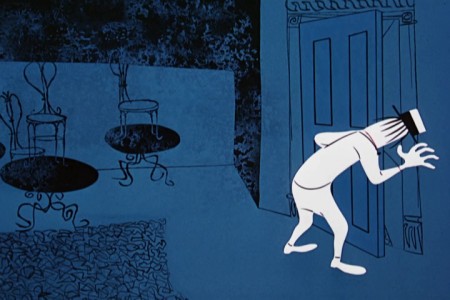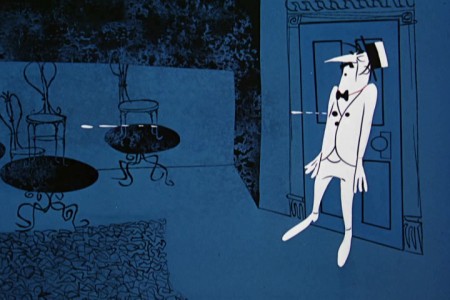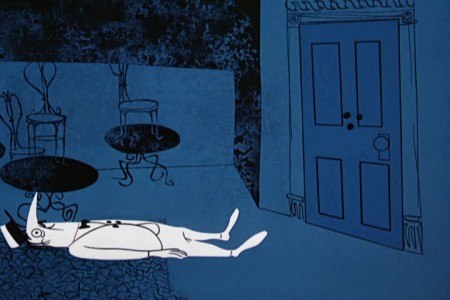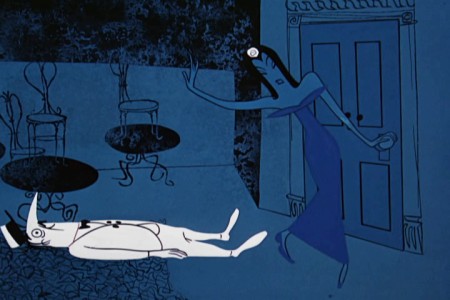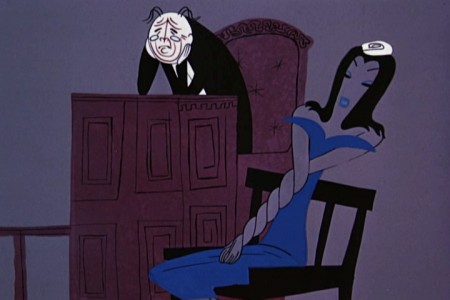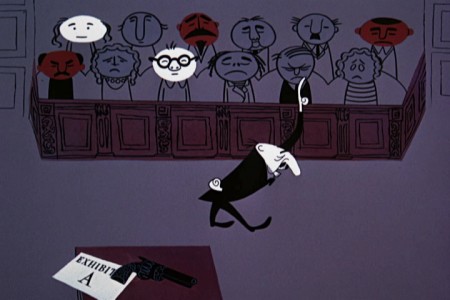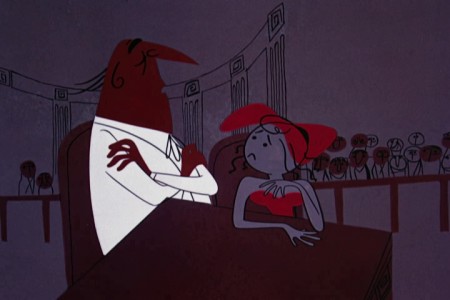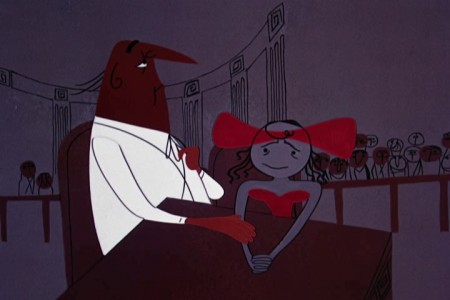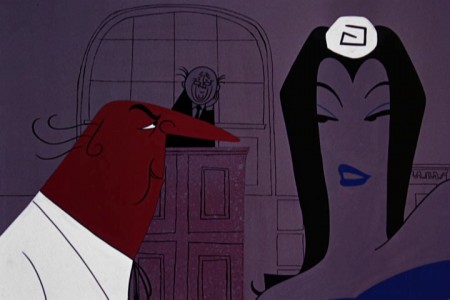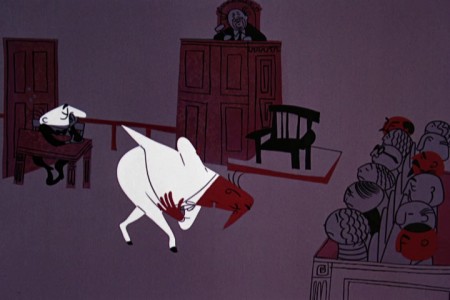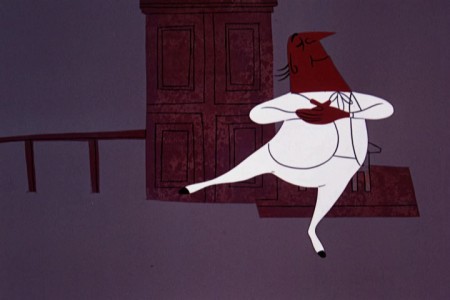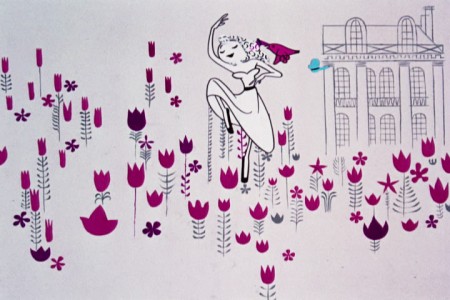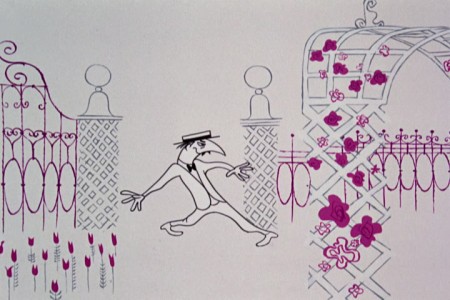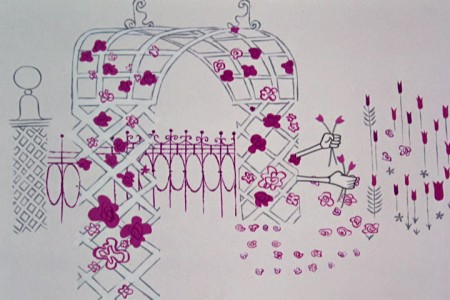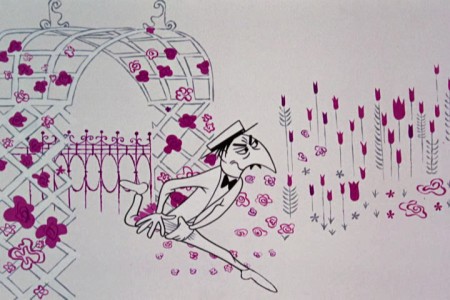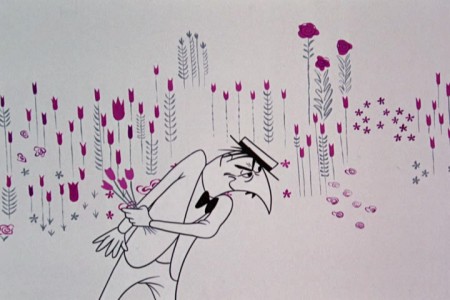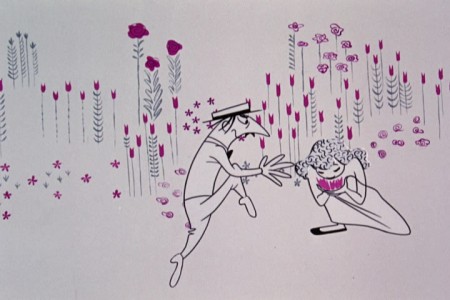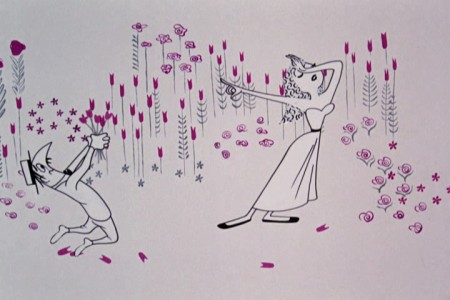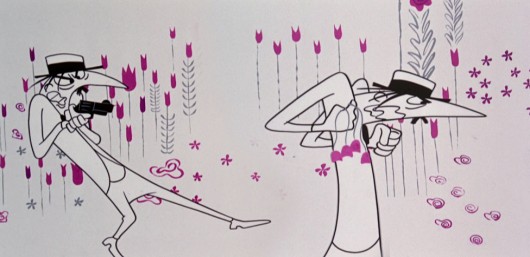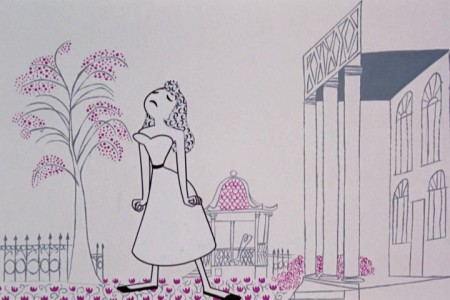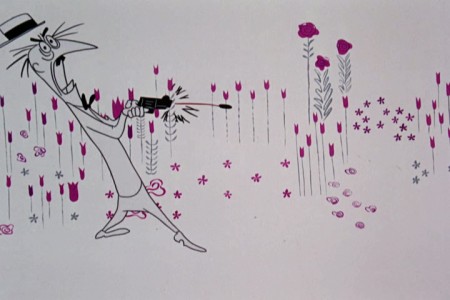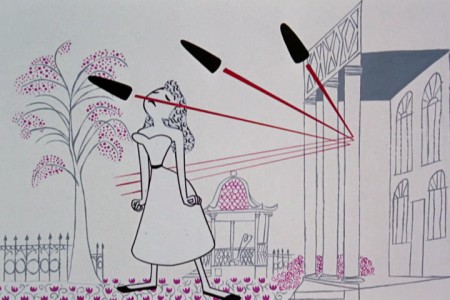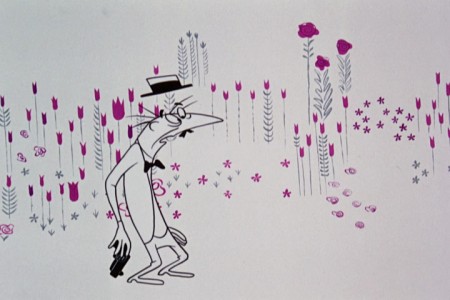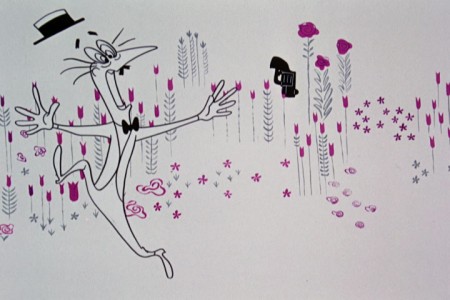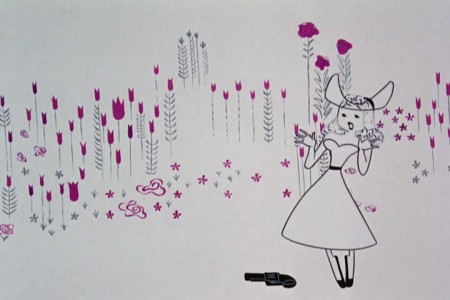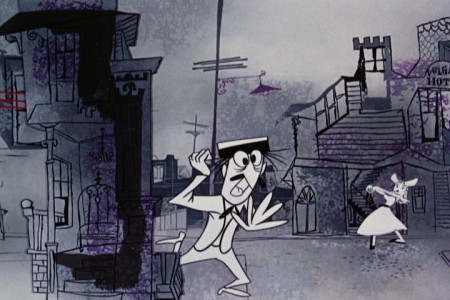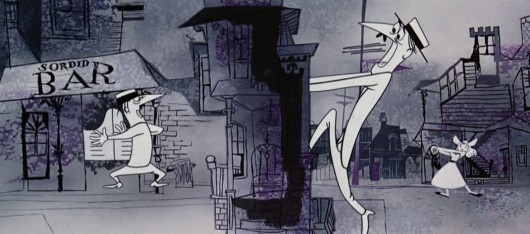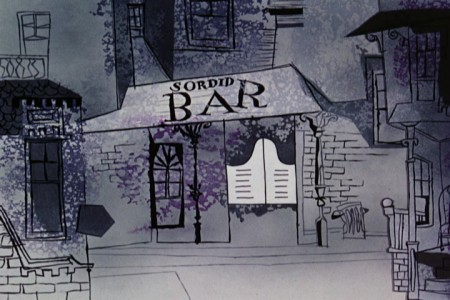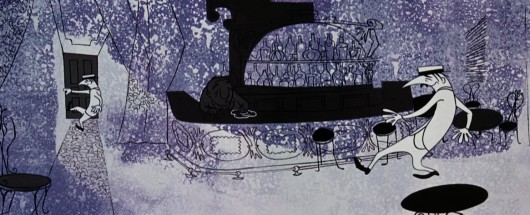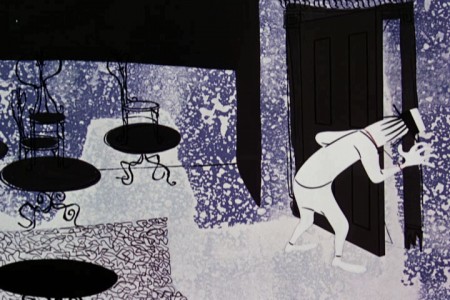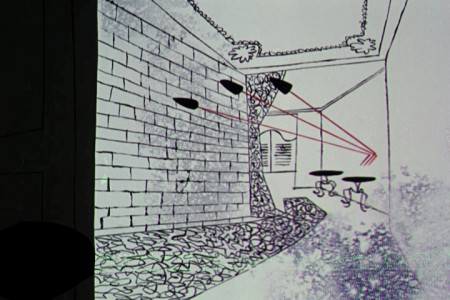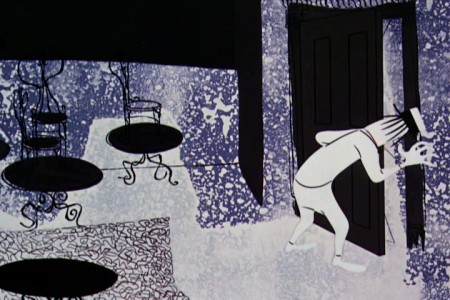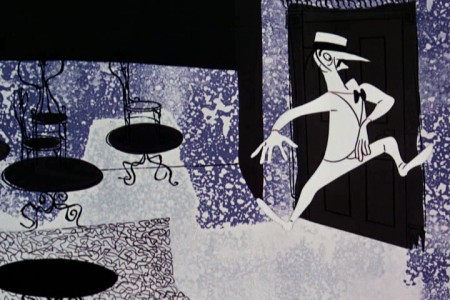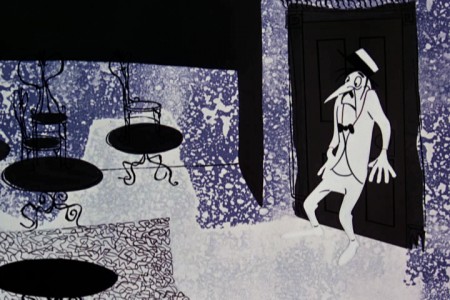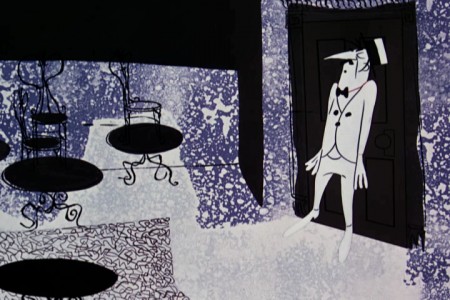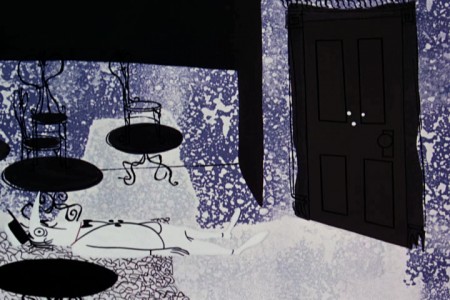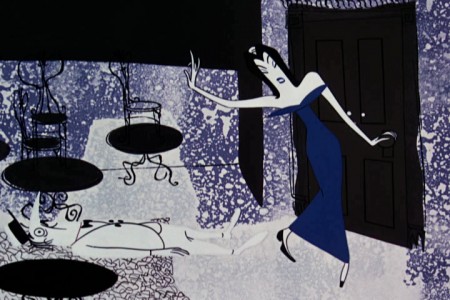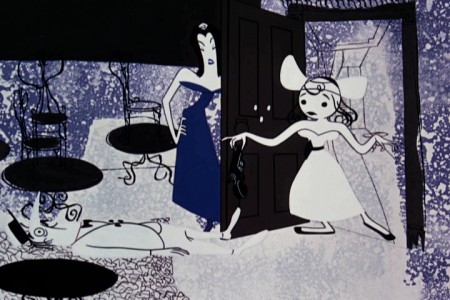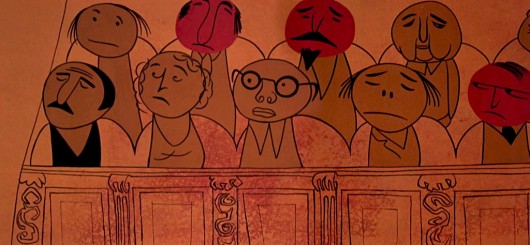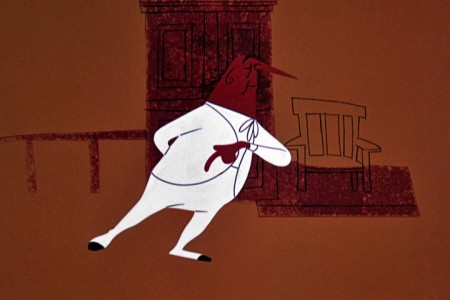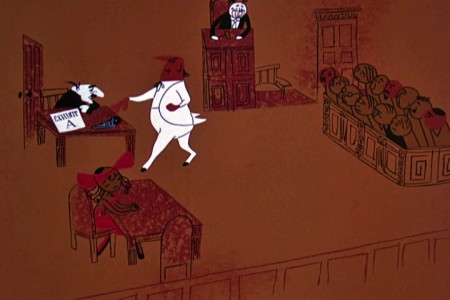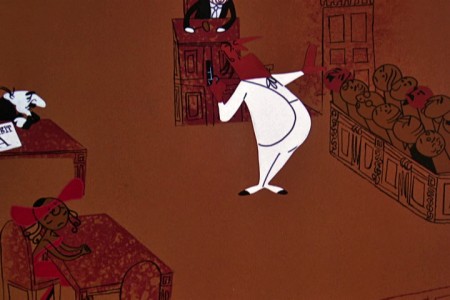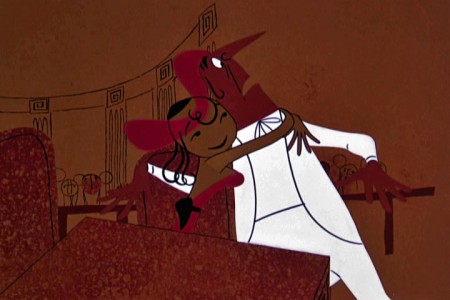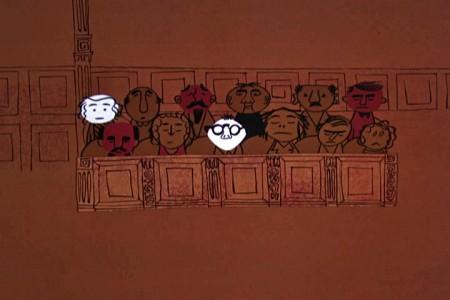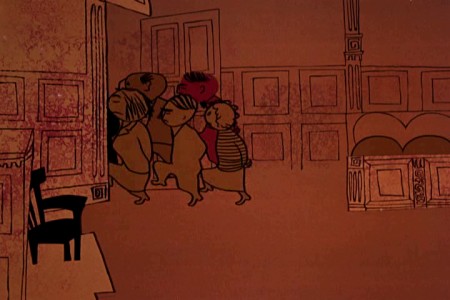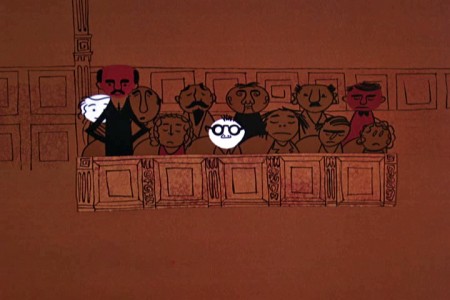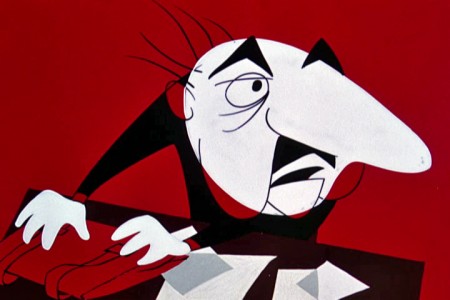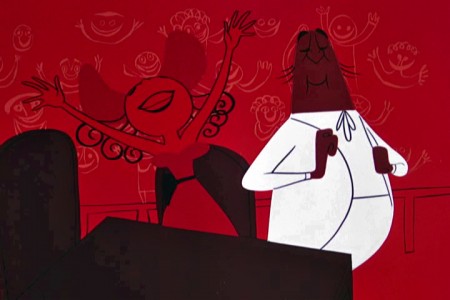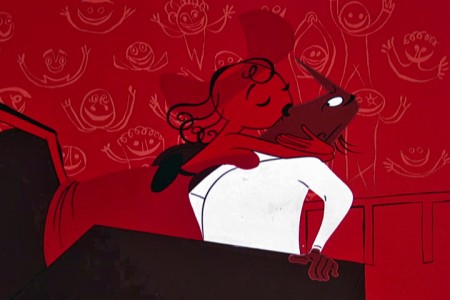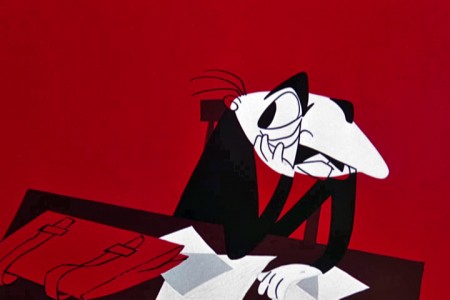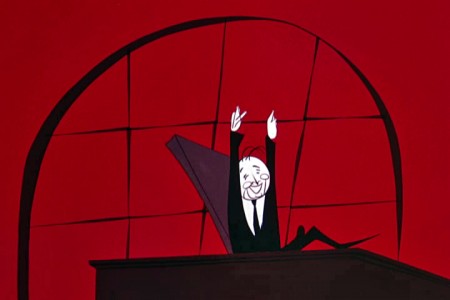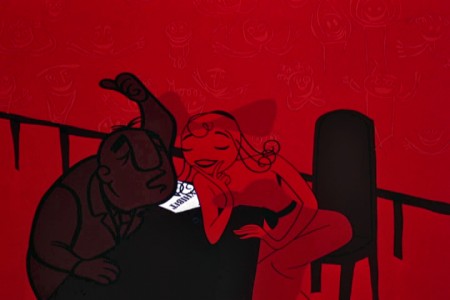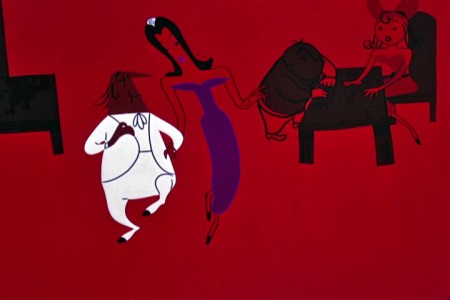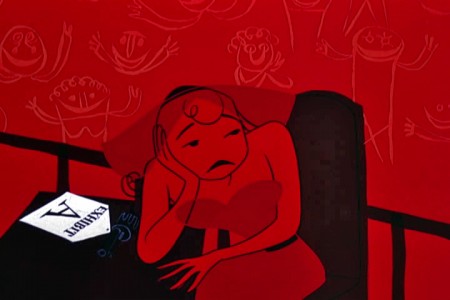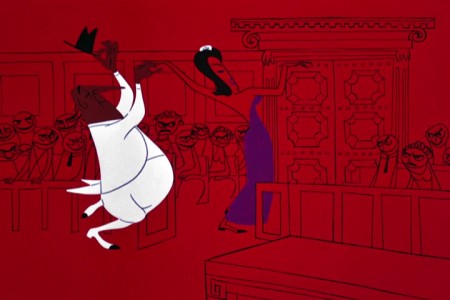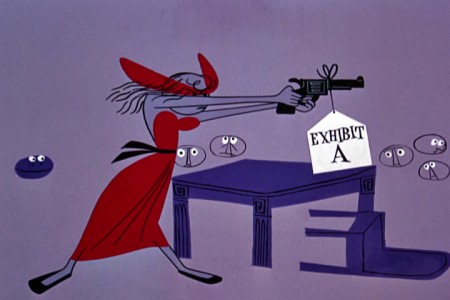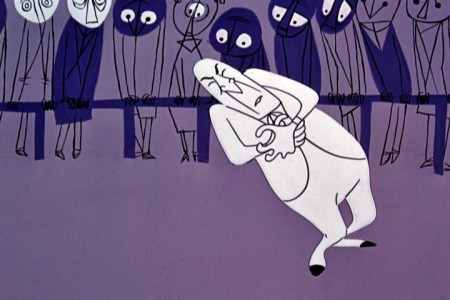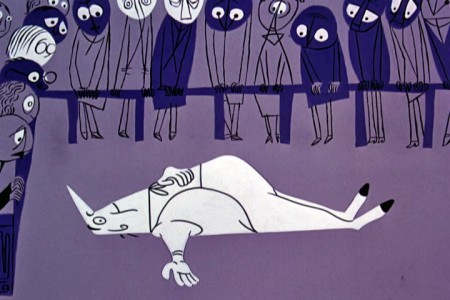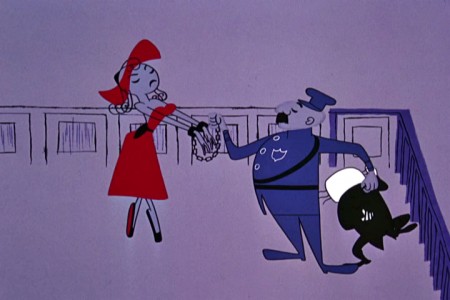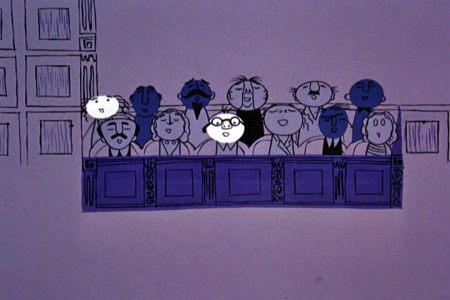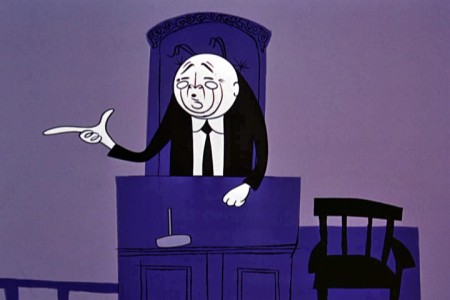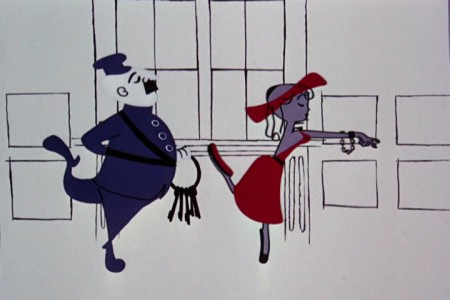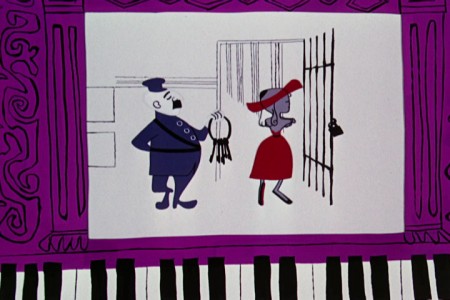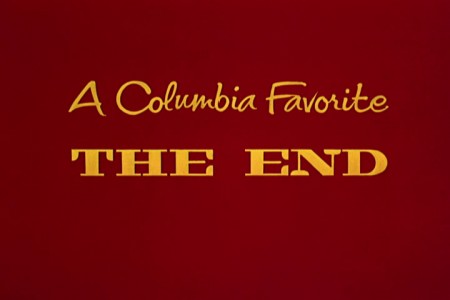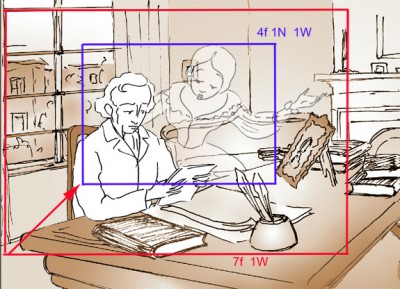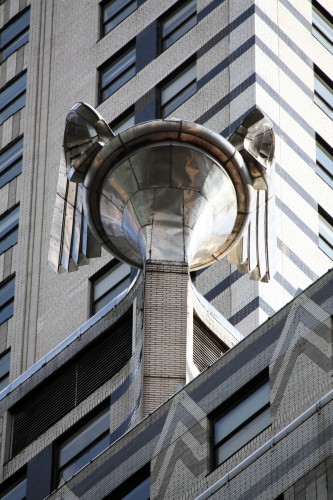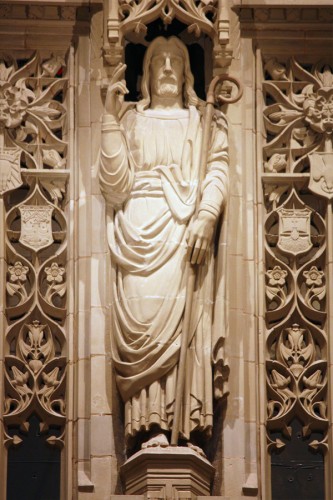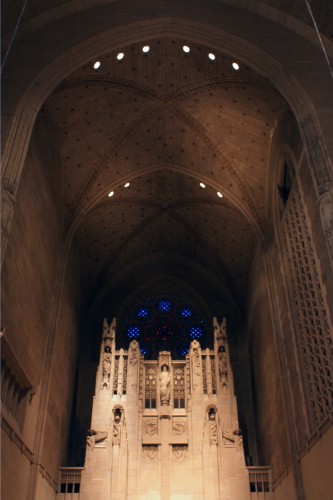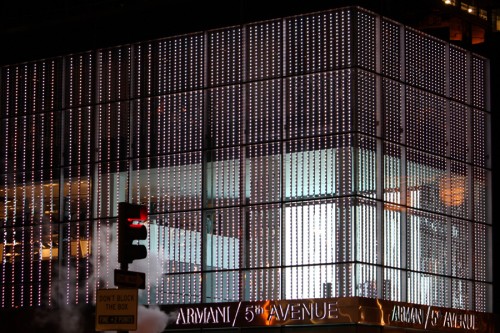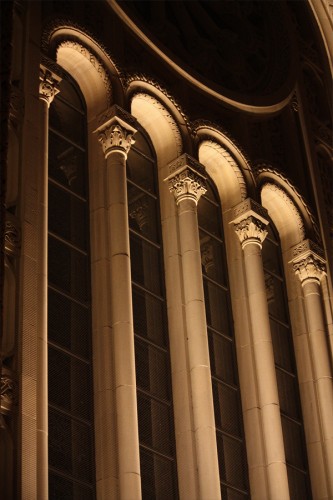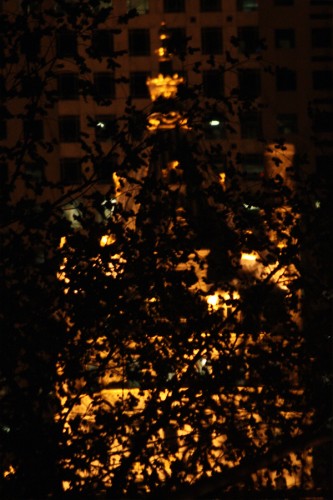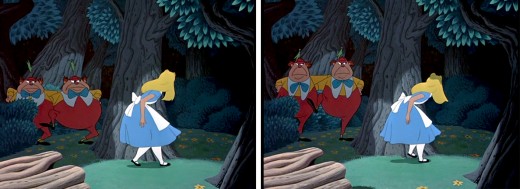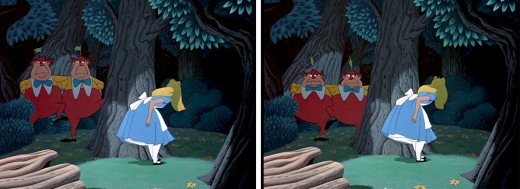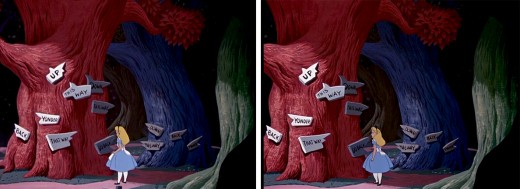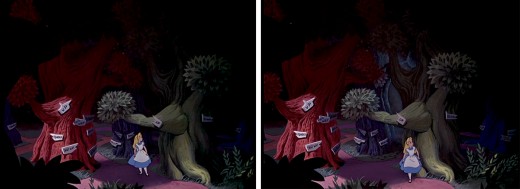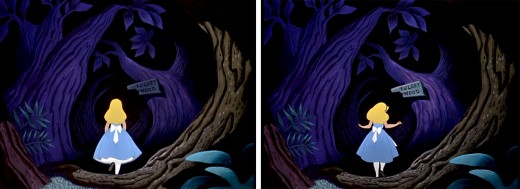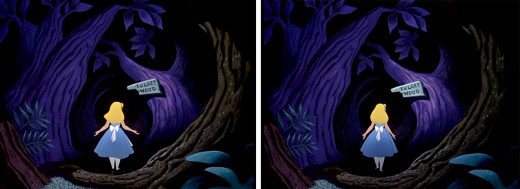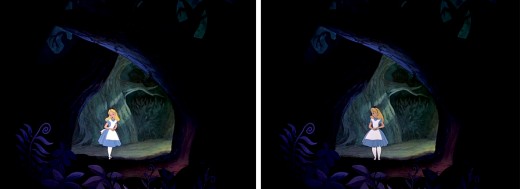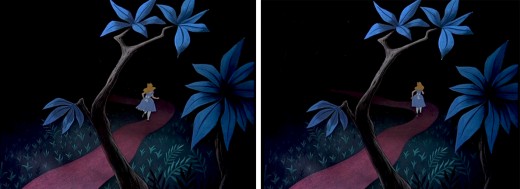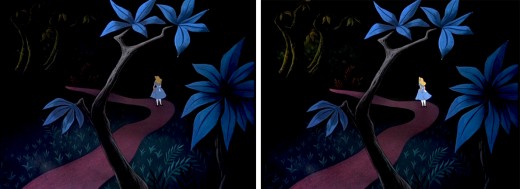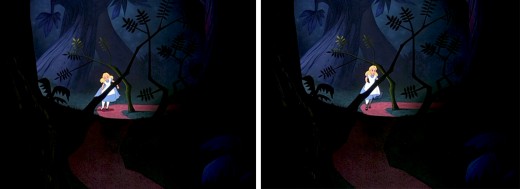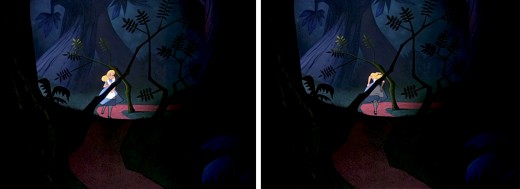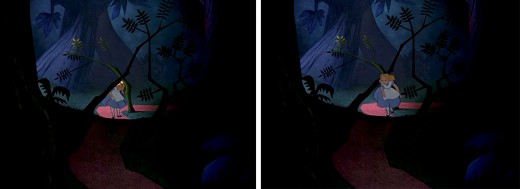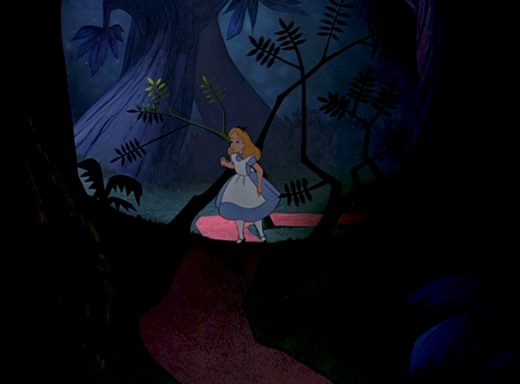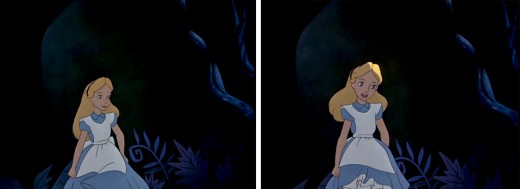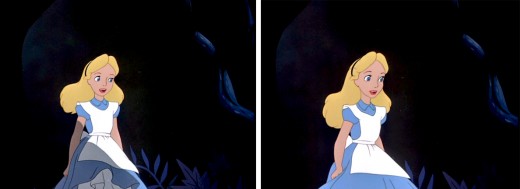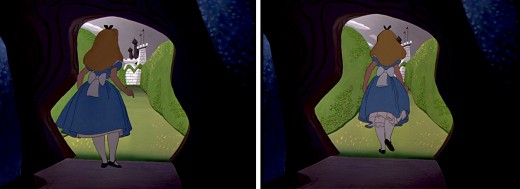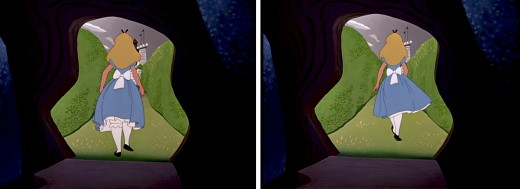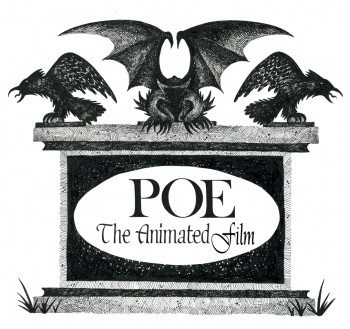Search ResultsFor "shadow"
Animation &Animation Artifacts &Disney &Hubley &John Canemaker &repeated posts 20 Aug 2012 05:53 am
Fantasia FX – Schultheis – recap
John Canemaker recently completed his latest book about Herman Schultheis and the effects department at Disney’s during the early 40s. It, hopefully, will be published in late 2014. This encouraged me to pull up this piece I posted in Sept/2009. It’s amazing how much information I was able to cull from the photos I found on the DVD.
I’m pleased with this post and am glad to repeat it for those who might not have seen it. John’s book, by the way, is one I’m looking forward to reading. He’s written a bit about it on his website.
- Herman Schultheis was an effects animator who worked on Fantasia. He kept a tight record of the effects they were creating from 1938-1941 and a photo display of how they were done. Schultheis disappeared in 1954 while trekking through Central America, and the notebook was forgotten until his wife’s death in the early 1990s, after which it was discovered by Howard Lowery behind the couple’s bedroom wall.
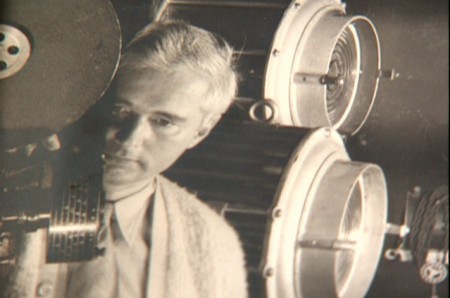
(Click any image to enlarge.)
Herman Schultheis created the book of charts and photos
which gives us a link to the many creative effects in the film.
The book is on display at the The Walt Disney Family Museum. It’s also been digitized so that visitors are able to go through the book, enlarge photos and view it page by page. An interactive display.
Prior to the discovery of the book we were able to figure out a few of the effects. One Disneyland show, in fact, recreated the bubbling lava scene from the Rite of Spring sequence.
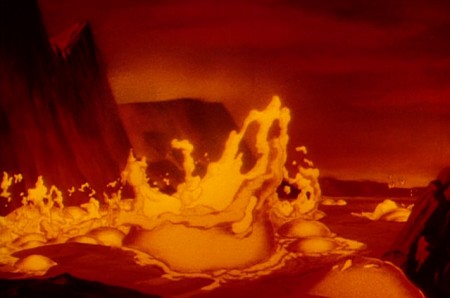
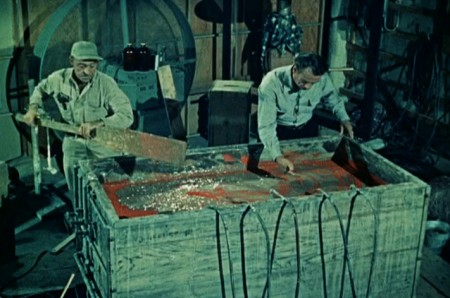
Josh Meador recreated the slow motion shoot of the
boiling concoction used to develop the bubbling lava.
However, the book revealed so much more than we’d understood
about how the superb effects had been crafted.
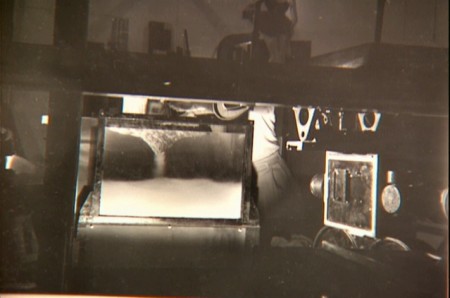
Using a vat of water, they were able to
drop ink into the liquid and film it in slow motion.
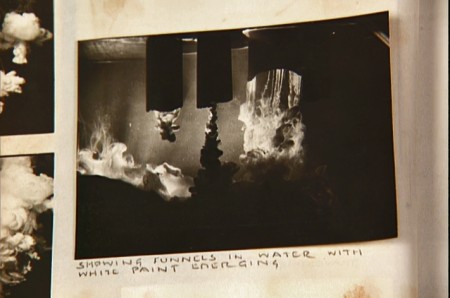
A photo of the ink spilling into the water behind built-in mattes.
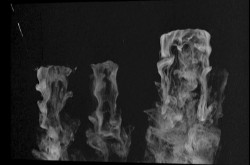
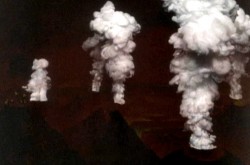
Taking the shot of the ink, they then turned it upside-down.
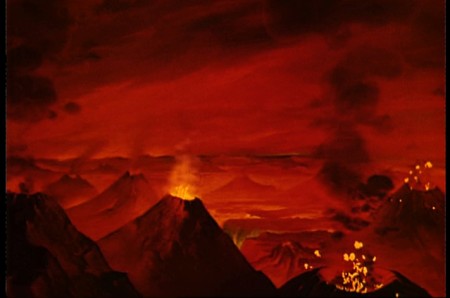
They then superimpose the “smoke” (or ink) over the volcanoes.
This same effect was used in Close Encounters of the Third Kind
to create clouds when the alien ships were moving in on the
farmhouse where the boy and mother lived.
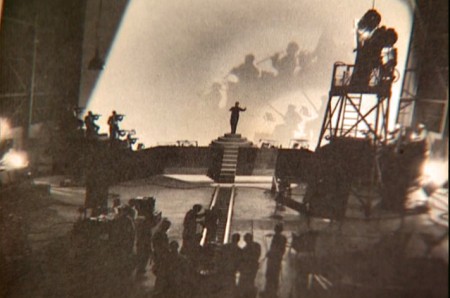
The orchestra was shot on a set with strong, planned shadows.
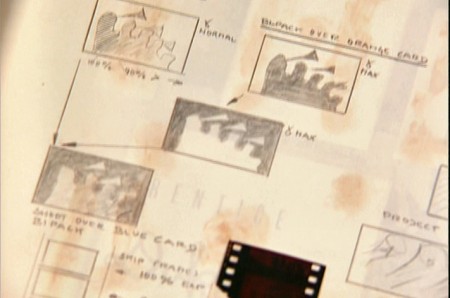
All these shots were orchestrated and planned for color effects.
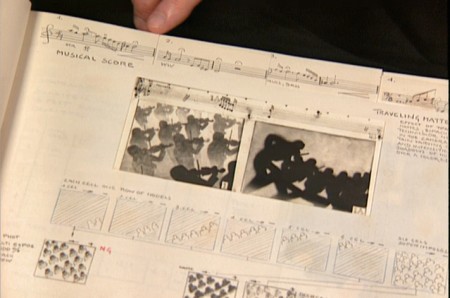
They were also catalogued by Schultheis who kept close
track of the music, as well, in his book. You can see a
page by page breakdown of the score at the top of the page.
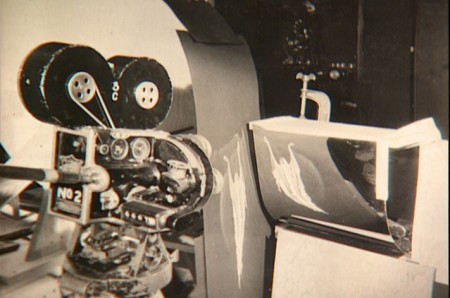
You can see the highly polished sheet of metal (middle left) which reflected
and distorted the animation drawings. This is what the camera photographed
in some of the scenes during the Night on Bald Mountain sequence.
It was also used for the fire in Bambi.
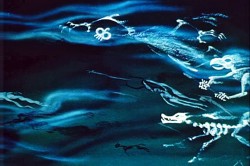 1
1 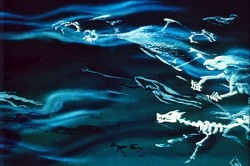 2
2
This scene’s ghosts were shot using that distorted metal reflection.
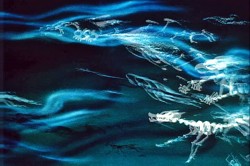 2a
2a 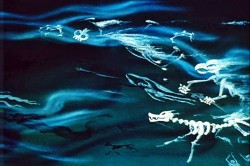 3
3
The ghosts also used a form of cross dissolve.
John Hubley explained to me how that was done, and
we used the technique in Everybody Rides the Carousel.
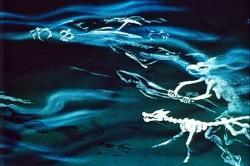 4
4 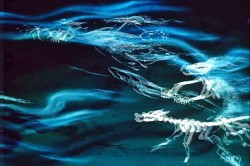 4a
4a
They shot the entire scene at 50% exposure. Then they went back
to the beginning and reshot the entire scene again at 50% exposure.
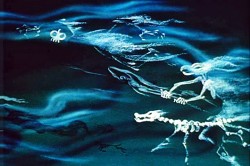 5
5 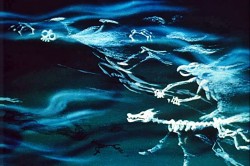 6
6
However on the second shoot, they started by shooting a black frame.
This made #1 fall where #2 should have been, #2 for #3 etc.
This creates a ghostly dissolve effect.
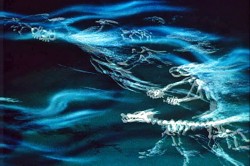 6a
6a 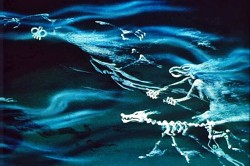 7
7
All of the drawings labelled with an “a” are the double exposures:
2a, 4a, 6a
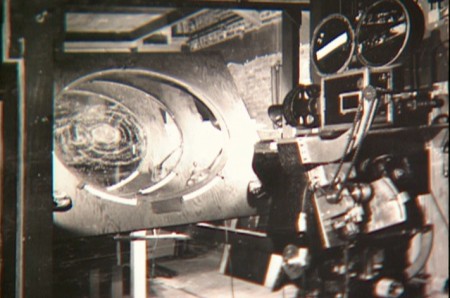
A make-shift circular multiplane camera was built.
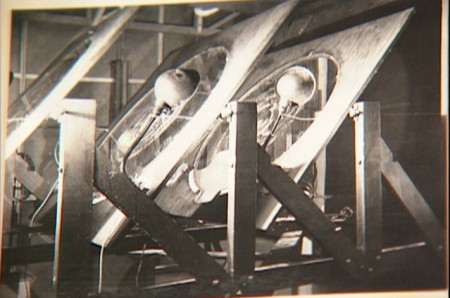
Created out of wooden sheets with holes cut out,
placed so they could shift angles, they were designed to
allow revolving artwork in the circular cut outs.

This allowed shooting scenes such as this shot of
a spider web as the camera moved around it
while dew glistened off of it.
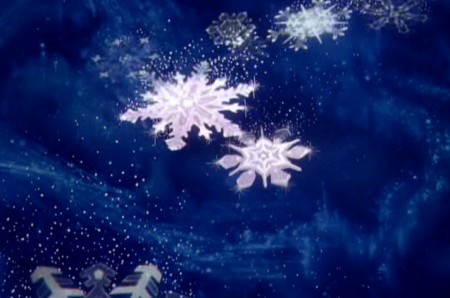
The spinning snowflakes are well explained in Schultheis’ book.
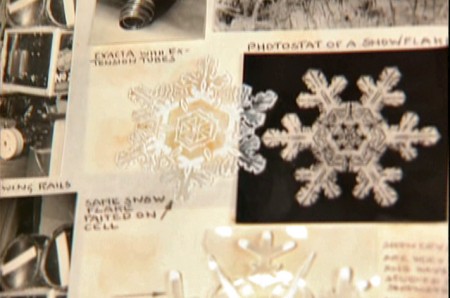
The snowflakes had a detailed construction.
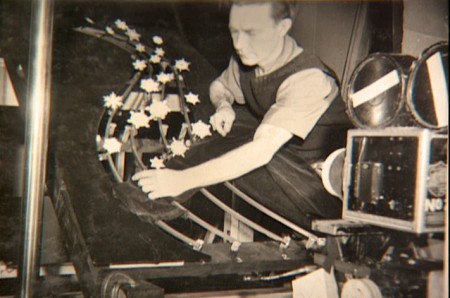
The path of action was intricately defined.
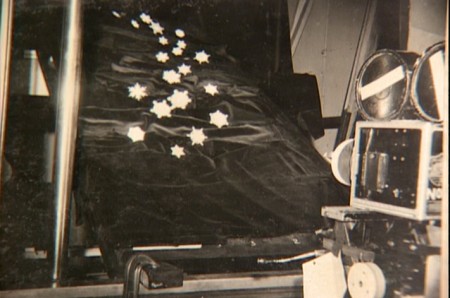
The snowflakes were shot against a sheet of
black velvet hiding the wire guides.
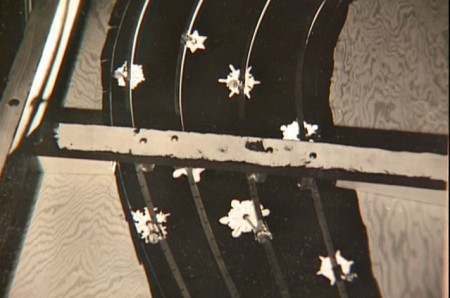
They were shot in tight closeup. From below you can
see the turning gears they were constructed on.
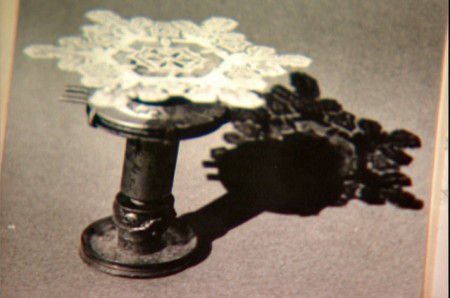
Each snowflake was built on a turning gear
so that they could revolve in their path of action.
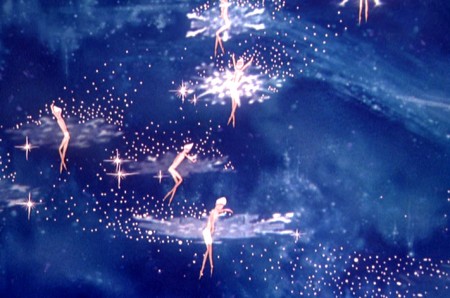
Burn these snowflakes over the multiplane background
and add matching 2D animated fairies within each snowflake,
and you have the finished scene.
Commentary 04 Aug 2012 06:21 am
Kenyan Notes and Other Stuff
The Kenyan Animation Industry
- Fraser MacLean, the author of the brilliant and beautifully illustrated book, Setting the Scene: The Art & Evolution of Animation Layout, contacted me a couple of weeks ago to introduce me to a young animator from Nairobi called Daniel Muli. Daniel is currently in New York for a short visit – he’s also a musician recording with his group – and Fraser was hoping to set up a meeting.
I’ve decided to give you a bit of that letter from Fraser and Daniel for you to get an idea of what was happening in Africa.
Daniel writes:
- “The Kenyan animation industry… It’s not the most active, sadly. It’s still in those early stages where everyone who’s trying to make it work is a crazy enthusiast, so I guess it makes for cool vibes when people get together, you get a lot of people trading information and stuff they’ve been watching, comic books they’ve been reading or whatever. Manga/anime’s pretty popular. And there’s a lot of people experimenting with what African art would be like translated into the animation medium.
- I guess another reason you find that most of the animators working right now are coming from a fan perspective is because the schools here are kind of uninspiring. I taught a couple of classes at one of them when I was in uni, and it was a difficult situation, the facilities, and students who were sent there more because they didn’t have much else to do rather than because they like the work… It was kind of exhausting. But the college I was at did a short intense course in collaboration with Truemax, a European 3D animation school, which seems to have gone well. (That was after I left.) There aren’t big employers of animators at the moment; the first and biggest so far was the Tinga Tinga Tales project that was done with Disney and the BBC.
Opening song from Tinga Tinga Tales.
See episodes of Tinga Tinga Tales here.
Fraser Maclean continues writing:
- Since that project wrapped, all the animators kind of just went back into the random freelance lifestyle. Some of them find less work in animation and more in design and advertising, or such things. I guess the best thing would be if we had more projects that were based here, and were a bit more sustainable, and I’m sure that’ll happen soon, but so far the attempts to start something, from u-nions to big film projects, are brought down by infighting and politics or whatever…
Does all this sound bleak?”
I did get to meet with Daniel this past week, and “bleak” is certainly not the word. We talked a bit about New York, a bit about Kenya. We met at Candy Kugel’s studio, Buzzco, and their EMMY on display got Daniel to tell me about Well Told Story a project he was involved with which won the first International EMMY for Africa. Much of his free-lance stories sound very much like freelancing in New York. In ways, animation is probably he same the world over.
Daniel Muli has made the most of his two week stay in New York recording for several days and performing for others. He’d also spoken at Bard College and today, Saturday, at 3pm he’ll perform in Central Park as part of their Summer Stage series. I’m looking to go and listen to his music. If it’s at all as vibrant as he, it’ll make for a great show.
Here are two of the creative (and community) projects that Daniel is currently involved in: go here and here.
- Summer Stage
Saturday, August 4, 2012 | 3 p.m.
Amadou & Mariam / Theophilus London / Just a Band
Presented in Association with: Museum for African Art
Free!
SummerStage is located at Rumsey Playfield near the 5th Avenue and 69th Street entrance to Central Park.
Take a look at Just a Band‘s music video samples below:
This one uses puppets.
Here’s one that uses flash animation.
______________________________
A Couple of New Animated Features
- Toys In the Attic is a multimedia animated film combining 3D stop motion, 2D animation, pixillation and live action. The film stars the voices of Forest Whitaker, Joan Cusack and Cary Elwes in their English language version. The film was directed by Jiri Barta, who is sometimes called the Tim Burton of the Czech Republic. The English version is being released to theaters on September 7th.
However, if you want to see the film sooner than that, it’s playing as part of the International Children’s Film Festival. That will take place on:
Saturday & Sunday, August 25-26, 11:00am
at the IFC Center.
May I also remind you that Cat in Paris (the Oscar nominated 2D animated feature from France) continues to play at the Cinema Village on 12th St & University Pl. This film has been playing in NY for three consecutive months. The film’s only an hour long, but it’s good. Go here for the schedule.
By the way Brave is also playing at the theater, and I’m not sure if it’s on the same bill – one price for both films. From the schedule it looks like it is.
Toys In the Attic is another of many 3D stop motion films being released this year, including one from Tim Burton, the American Tim Burton. That one is Frankenweenie. Paranormal will be released within the next month. That’s a big budget stop motion feature that comes from Laika, the Oregon company that financed Henry Selick‘s last film, Coraline. They apparently felt they could get along well without Mr. Selick. It’ll be curious to see what they do without him: it’ll be fun to see if they did.
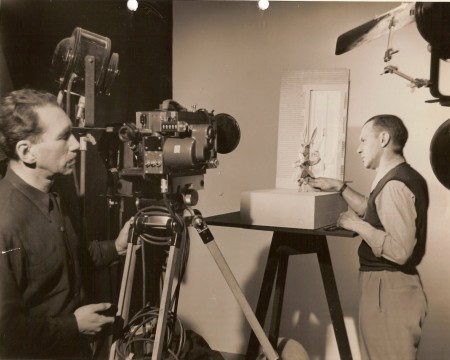
Lou Bunin behind the camera on Alice
- A 3D puppet animated feature from 1950 will have it’s last theatrical showing of the season this coming week. The Museum of Modern Art is screening Lou Bunin‘s Alice in Wonderland this Monday at 8pm. This film gave Disney agita when it was released at the very same time as his Alice feature. He tried to stop the American release of Bunin’s film, but lost that contention.
I previously wrote about this Bunin film here and here and here and included the NYTimes press clipping about the Disney vs Bunin trial.
Dreamworks Sets Their Schedule
- DreamWorks Animation has announced its release calendar through 2014, setting dates for seven animated features.
-
Madagascar 3 opened on June 8
Rise of the Guardians will open in theaters Nov. 21, 2012.
The Croods goes out on March 1, 2013.
Turbo bows on June 7, 2013.
Me and My Shadow, combining traditional animation with CGI, opens Nov. 8, 2013.
Mr. Peabody & Sherman goes out in theaters March 21, 2014.
How To Train Your Dragon 2 opens June 20, 2014.
Art Meets Animation
- Richard O’Connor (Ace and Son) directed me to a gallery showing in New York currently on display. Suzan Pitt‘s film, Asparagus is on display at the Harris Lieberman gallery at 508 West 26th Street, in Chelsea, through Aug. 17th. It’s quite amazing that a 33 year old film is still circling the art galleries and getting the lead attention in the NYTimes art reviews. Congratulations to Suzan Pitt, proof positive that animation can be art.
- Richard also noted that Natalie Djurberg has a show at the New Museum.
Art News reports: The Swedish artist Nathalie Djurberg works with animation films which are inhabited by clay figures in a strange universe. The short films are often no longer than five minutes but they manage however to tell stories about the human condition mixed both with black humour and seriousness.
Art and animation mix in NYC.
MoCCA Moves
- A couple of weeks ago a small article in the NYTImes (July 10th, to be exact) reported with this headline: Museum of Comic and Cartoon Art Says That’s All, Folks – for Now. The article read; “The MoCCA, in SoHo, announced, without elaboration, on its Web site on Monday that it was closing its “physical location,†effective immediately.”
It continued: “’Plans are afoot to continue MoCCA in a new and exciting incarnation,’ according to a statement on the Web site.”
Then yesterday I received an email from MoCCA. This one stated: The Museum of Comic and Cartoon Art (MoCCA) and the Society of Illustrators have announced plans for MoCCA to transfer its assets to the Society, creating a single cultural institution supporting and celebrating illustration, comics, and animation. This will give MoCCA a long-desired street-level location, in the Society’s building at 128 E. 63rd Street.
So there you have it; life goes on.
Animation Artifacts &repeated posts &SpornFilms &Title sequences 08 Jul 2012 07:05 am
Prince of the City – recap
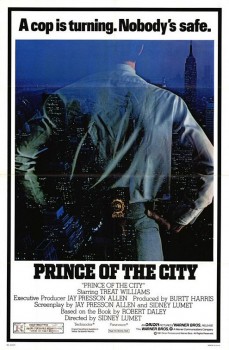 - One of my studio’s very first jobs was to do the titles to a big Sidney Lumet feature film, Prince of the City. (Feb, 1980) The film was a hard-nosed crooked cop drama brilliantly directed by Lumet. The problem it had was that few of the actors in the large cast were known, and the audience was having a recognition problem. Treat Williams was in his break-out role and the only other identifiable actor was Jerry Orbach.
- One of my studio’s very first jobs was to do the titles to a big Sidney Lumet feature film, Prince of the City. (Feb, 1980) The film was a hard-nosed crooked cop drama brilliantly directed by Lumet. The problem it had was that few of the actors in the large cast were known, and the audience was having a recognition problem. Treat Williams was in his break-out role and the only other identifiable actor was Jerry Orbach.
I was hired to ID all of the cops, lawyers, good guys and bad with what-looks-like live action identification cards. I also did title cards throughout the film, breaking it into chapters. Finally there were the end credits (no opening credits.)
I pulled in a friend and film genius, Phillip Schopper. Together we shot the actors with Polaroid film trying to make the photos look a bit cheesy, as the real items would. Phillip took the Polaroids and doctored them to our needs. Treat Williams, for example, had moved onto another film and came back only for these photos. His hair was now jet black for the new movie, so Phillip had to recolor his hair in the doctoring (in those years before computers.) Jerry Orbach had a blemish on his lip that he wanted retouched. There were plenty of little things to deal with on the photos.
I had to locate the real identification cards (NYC police dept, NYState Supreme Court judges and DA’s, etc.)
Then I had to forge them. I worked with a printing shop in NY that didn’t ask questions. We chose to actually print the cards as if they were done via mass production so that they would look authentic. The cards should have that slightly embossed feel as if the letters were pressed into the card stock. (Printing these days has the type laying on the paper without pressing into it.) I also had to find appropriate paper and laminating machines to get the actual look of these cards. This was all done before the wide use of computer technology.
We had to film the sequences.
We worked with animation cameraman, Gary Becker for about a week and took over his Oxberry. We built miniature sets to hold the ID cards at odd angles, and we relit the cards with shadows built in. We wanted these cards to have a gritty reality to them that an animation stand didn’t generally offer.
The cards were animated moving as if a machine were printing them or a folder were being opened or papers were being tossed aside. This involved a lot of work getting out-of-focus images in the animation. When a folder opens, it moves in soft focus. The folder will pick up the top sheet and let that drop back again. We had to manipulate this all in stop motion to get it to work properly.
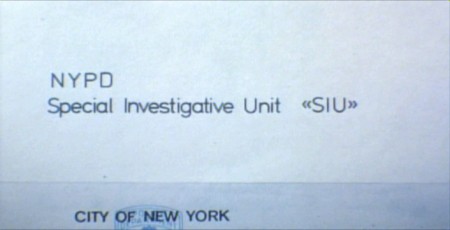
(Click any image to enlarge.)
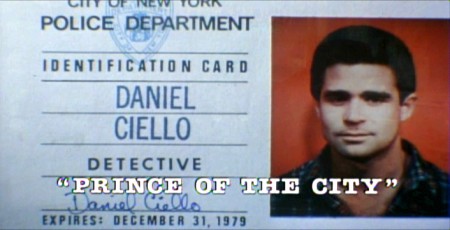 10
10
These cop cards (about five of them – one for each
of the five cops) appear twice. Once for the new enthusiastic cops.
Another for the tired and jaded cops.
There were about 8 insert sequences about a minute each.
When it came time for the end credits, we chose to include photos of the actors with their names so that people would be able to recognize them from the film, without having to have had to memorize their characters’ names. We pushed these cards up as if a machine were printing the titles, a card at a time. The cards had to move in out-of-focus, as well. It was long and arduous shoot.
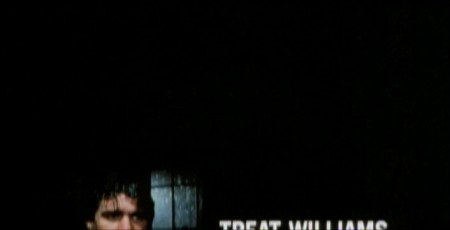
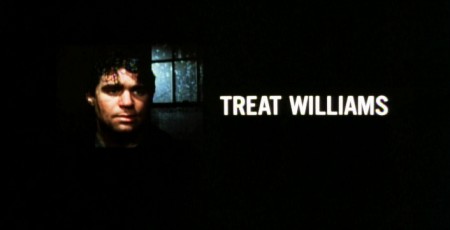 4
4
All of the credits came up at varying speeds, timed to the music.
This was helpful in that all titles go through changes after they’re done.
Our system gave us a lot of flexibility to addd or change cards as
necessary without having to reshoot them all.
Sidney Lumet didn’t want me to have a company credit. I couldn’t include the studio name, Michael Sporn Animation, Inc. because he felt that people would try to figure out what was animated. He didn’t want them to know there was any animation in the film. Hmmmm.
I put both my name and Phillip’s as doing the titles and insert shots.
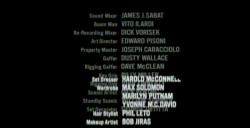 1
1 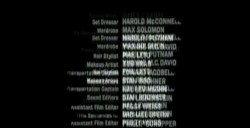 2
2
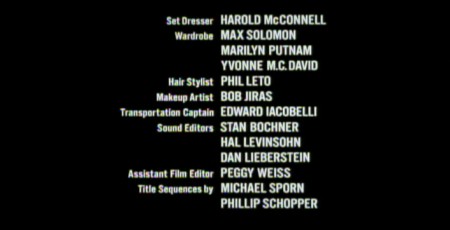 3
3
There’s actually a four frame fade out of the old credit list
as the new list zips up and in / out-of and into-focus.
I did quite a few other title sequences for Sidney as a result of this job, and I was pretty proud of the film and the job that I had done.
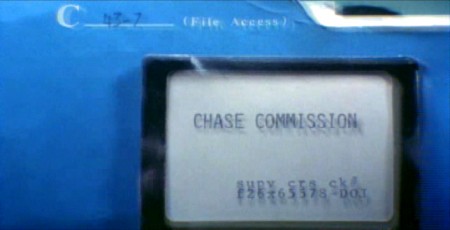 1
1
Records in a folder. The embossed stamp was a headache.
We shot the back of a card’s actual stamp in shadow, then we
printed it on a document in reverse on the front of our card.
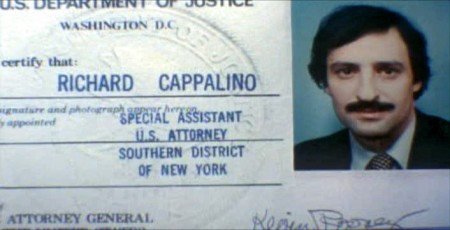 6
6
.
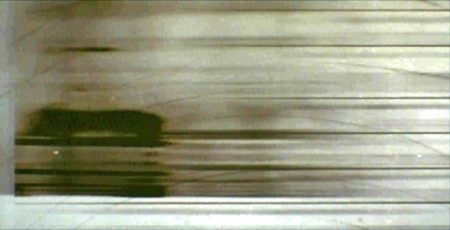 1
1
The microfilm look for mug shot records.
The slightly bad guys in B&W.
Commentary 30 Jun 2012 07:11 am
Awards, Animated Oscars and other movies
- Back in February, I got a real kick when I found out that I’d won the NAACP Award for Outstanding Children’s Programming for my show, I Can Be President. HBO told me that they would get my award and send it to me. Great to have a big-sized advocate.
This past Monday, I suddenly remembered that award and emailed HBO about it. I wondered where it stood. They found it at HBO and said they’d send it to me. Since I live about a dozen blocks from HBO, I planned to pick it up, myself, from HBO. They said it might be better if I let them deliver it.
Turns out that the award weighs a ton, and is pretty big. I’ve taken a couple of pictures of the prize and am posting them here. I couldn’t be prouder. Yet, again I thank the artists that worked with me to get out this film: Matt Clinton and Katrina Gregorius. I also thank Christine O’Neill who did all the behind-the-scenes work to make the production possible.
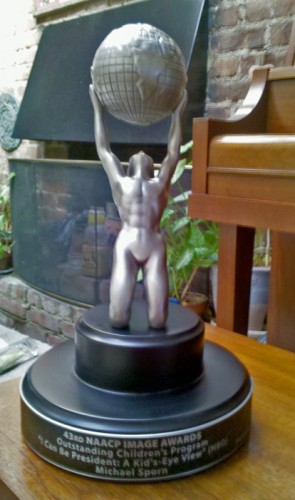 1
1
It has to weigh somewhere between 25-30 pounds.
____________________
- Congratulations to Emily Hubley who was just voted in as a member of the MP Academy. Another New Yorker in the group! If you ask me, it’s been a long time coming. She’s been making films longer than many of the other members, and is such a serious and devoted
animation artist. She’ll be a credit to the group. 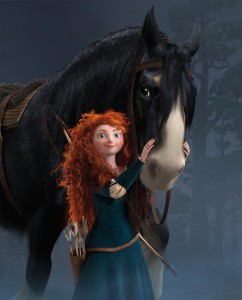
I like the fact that there seems to be a large number of strong animated features coming out this year. Brave is the formidable release this year, and I expect it’ll be hard for other films to beat it. Madagascar 3 has gotten such positive attention that I’m almost encouraged to see it, myself. Ice Age 23 will be out mid July. Just in puppet animation we have Frankenweenie, ParaNorman, and Hotel Transylvania; all of which feature monsters. And there are many more a comin’ It’s a big year for animation.
Epic looks like the most interesting of them all, though shades of Arietty overshadow it for me. (Actually, Arietty has been my favorite release of this year.) Epic will be released by Fox in 2013. Maybe that’ll be a big year, too.
- Bill Benzon has another excellent article on his site, New Savannah. This time he discusses the “metaphysical implications of animation as a medium, specifically, animation as opposed to live action film-making.” It’s a good read about animated elephants, particularly those in Dumbo.
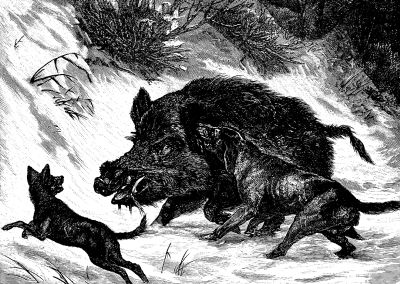
- And speaking of Miyazaki, the new movie, Beasts of the Southern Wild, features a few scenes right out of Princess Monokone. There’s a slew of enormous wild boar with tusks and temperament that torment the lead character, Hush Puppy. The confrontation scenes at the end of the film have almost as strong emotional weight and power as Miyazaki has brought to them, even though this seems to be live action (with cgi help). A.O.Scott of the Times said that “Beasts of the Southern Wild is a work of magic realism and, to some extent, an exercise in wishful thinking.” It’s a raw version of Terrence Malick, but that could just be the immaturity of the filmmaker. This is his first movie, and he’s only 29. But then his brilliant star is just six years old, and she gives the year’s best performance so far.

This was certainly the movie of the week, far better than To Rome With Love (even though I’m a Woody Allen junkie.) This film seemed miscast, poorly acted (Penelope Cruz just is wrong for the part and not trying to act in it) and sloppily written. I haven’t seen Ted, but I’ve enjoyed the trailers I’ve seen. I’d expect the worst from Seth MacFarlane, though I usually laugh at some of his stupid jokes. He’s, at least, sweeter than Adam Sandler.
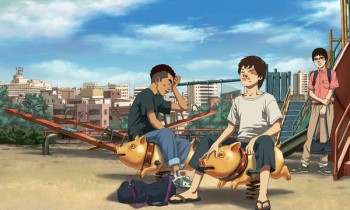 There is another animated feature currently playing in New York. The Korean film, King of Pigs, will play at the Korean Film Festival at the Walter Reade theater in Lincoln Center Saturday & Sunday July 7th & 8th. The film has been compared to Lord of the Flies.
There is another animated feature currently playing in New York. The Korean film, King of Pigs, will play at the Korean Film Festival at the Walter Reade theater in Lincoln Center Saturday & Sunday July 7th & 8th. The film has been compared to Lord of the Flies.
The film and the Festival were reviewed well in the NYTimes yesterday. There are also another two animated korean features in the Festival. There are also Asura Thursday, July 12th and Gyo Saturday, July 14th. Go to the schedule to read more about these films or to buy tickets in advance.
Tomorrow, I have some old photographs of animators from days gone by (the 50s).
I like that post, and I think you will too.
Commentary 09 Jun 2012 05:54 am
Snow White & Paul Williams
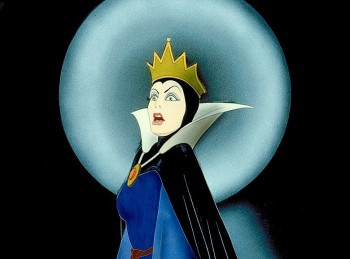 - We all know Snow White was the first animated feature. On Thursday I got to see the most recent version of the fairy tale, Snow White and the Huntsman. Times have changed, and animation is no longer animation. In reality, today, animation is a combination of live action combined with a digital puppetry. The purest form of these films, to me, is not the product of Pixar or Dreamworks; it’s these live action hybrids that overuse special effects, to the point where they’re no longer special. They’re just a bombardment of effects. Snow White and the Huntsman is a good example of one of these overeffected films.
- We all know Snow White was the first animated feature. On Thursday I got to see the most recent version of the fairy tale, Snow White and the Huntsman. Times have changed, and animation is no longer animation. In reality, today, animation is a combination of live action combined with a digital puppetry. The purest form of these films, to me, is not the product of Pixar or Dreamworks; it’s these live action hybrids that overuse special effects, to the point where they’re no longer special. They’re just a bombardment of effects. Snow White and the Huntsman is a good example of one of these overeffected films.
 Like the film, Mirror Mirror, another pathetic attempt to rework the same tale, this film stars a superstar actress as the Queen mother/witch. That means that the film is no longer Snow White, but it’s about Snow White’s mother. To boot they get some young “star” who isn’t up to the challenge to play “Snow White.” Kristen Stewart gets top billing over Charlize Theron, yet, in my opinion, she can’t walk in the shadow of Ms. Theron. She can’t act as well and she sure isn’t as beauiful as the Stepmother/Queen. What you really need in this role is a young Elizabeth Taylor, someone as stunningly beautiful as that. She has to be more attractive than Charlize Theron. That’s what it says in the script; it’s key to the story. Maybe my values are messed up; but I don’t see Kristen Stewart as anything more than ordinary looking, and I don’t call her aimless self-reflective movement anything close to acting.
Like the film, Mirror Mirror, another pathetic attempt to rework the same tale, this film stars a superstar actress as the Queen mother/witch. That means that the film is no longer Snow White, but it’s about Snow White’s mother. To boot they get some young “star” who isn’t up to the challenge to play “Snow White.” Kristen Stewart gets top billing over Charlize Theron, yet, in my opinion, she can’t walk in the shadow of Ms. Theron. She can’t act as well and she sure isn’t as beauiful as the Stepmother/Queen. What you really need in this role is a young Elizabeth Taylor, someone as stunningly beautiful as that. She has to be more attractive than Charlize Theron. That’s what it says in the script; it’s key to the story. Maybe my values are messed up; but I don’t see Kristen Stewart as anything more than ordinary looking, and I don’t call her aimless self-reflective movement anything close to acting.
For the first half hour of the film things move along like a traditional animated feature. Lots of beautiful composed and constructed sets and costumes and really special effects. It’s hard to tell the animation from the live action. Trees are moving of their own accord, costumes move, animals move in orthodox ways. It’s thoroughly engrossing. Then the film goes Celtic as they leave the castle on the chase/journey. Through the scary dark woods, past a village of women, into the realm of fairies where the seven dwarfs are a wonderful special effect. Great British and Irish acors like Ian McShane, Eddie Marsan, Bob Hoskins and Toby Jones are shrunk to look like dwarfs. The effect is totally believable, and the actors are wonderful.
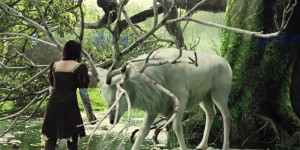 This is where the film tells us it’s an animated movie. There are two creatures literally ripped right out of Miyazaki’s Princess Mononoke. Scenes from that animated feature are reproduced exactly for this Snow White. It’s not even original enogh to create its own gods, it has to steal Miyazaki’s.
This is where the film tells us it’s an animated movie. There are two creatures literally ripped right out of Miyazaki’s Princess Mononoke. Scenes from that animated feature are reproduced exactly for this Snow White. It’s not even original enogh to create its own gods, it has to steal Miyazaki’s.
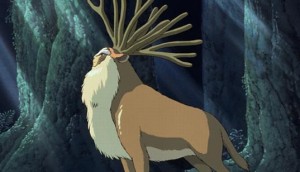 Then there’s the journey back after a couple of fights. Then there’s the poison apple (well done, I might add) and eventually the first love’s kiss brings on the resuscitation of Snow White. The problem is, that isn’t the end. Now Snow White has to become Joan of Arc or is it (Henry V) to do battle with the evil Queen.
Then there’s the journey back after a couple of fights. Then there’s the poison apple (well done, I might add) and eventually the first love’s kiss brings on the resuscitation of Snow White. The problem is, that isn’t the end. Now Snow White has to become Joan of Arc or is it (Henry V) to do battle with the evil Queen.
They’ve taken the fairy tale and turned it on its ear, so that it really doesn’t have much significance anymore. Her name is “Snow White”, she’s supposed to be innocent! Love’s first kiss should be the end of the story. It’s just the introduction of the heroine, who earlier told us she could never kill anyone, who will lead us into battle. The film is ultimately just the means for a lot of effects. The one that gets a bit old is the transition of objects (birds, soldiers, anything on screen) into shiny shards of shale-like stone. Flecks of things go flying everywhere, over and over again. It works well the first three times but a dozen times later, we’ve seen it.
The film, at one point, really is onto something, but that gets lost and it certainly loses the message of the fairy tale.There’s something there until it’s no longer there. Too bad.
But it’s still miles north of The Avengers or some of the superhero films we’ve seen this summer. And it does have Charlize Theron. Onto a screening of Prometheus, this coming Monday, also with Charlize Theron. A different kind of animated feature. Personally, I wish it were a new Miyazaki film.
 - For many years, I was a big fan of songwriter/singer/actor, Paul Williams. I collected all of his albums back in the 70s and 80s and went to see him in concert a couple of times. I tolerated his acting in a lot of horrible movies (like the Smokey & the Bandit series) and tv shows (like Baretta, The Gong Show and The Love Boat) which almost mocked the seriousness of his music, and I still remained something of a fan.
- For many years, I was a big fan of songwriter/singer/actor, Paul Williams. I collected all of his albums back in the 70s and 80s and went to see him in concert a couple of times. I tolerated his acting in a lot of horrible movies (like the Smokey & the Bandit series) and tv shows (like Baretta, The Gong Show and The Love Boat) which almost mocked the seriousness of his music, and I still remained something of a fan.
In the past couple of weeks, I received an invitation to attend a new documentary called, Paul Williams:Still Alive, at a private screening and then to meet up with Mr. Williams at a post wine and cheese thing. Naturally enough, I jumped at the chance and went to this screening last Monday evening at the HBO screening room in town. The fear I had that this might be more like one of those bad 70s movies that Mr. Williams starred in was negated immediately when I’d read an interesting interview he did with the NY Times. It got me in the mood to see this film.
Surprisingly, the film started just about on time. It was introduced by its director, Stephen Kessler. His introduction was very short and led us right into the film. The theater was full, as a matter of fact this screening room has a second room attached which projects the film onto that second screen simultaneously. Both were full, and I’ve seen several reviews come out of this particular screening..
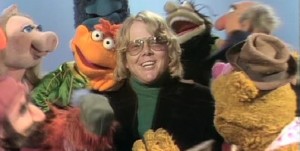 The film starts out about a fan (the director) who hounds a celebrity until he gets to interview him and then makes him the subject of his documentary. At first, it almost seems as though the film were more about Steve Kessler than about Paul Williams. But in the small moments with Mr. Williams, on film, you see that he is beginning to control the film, for the better sake of the movie. Right at the start, Willliams suggests that the film should not be one of those where the voice of the questioning film maker is cut out, so the ego of the “star” is hung out to dry. He pulls Mr. Kessler into the shot and tells him that the film has to be about the two of them.
The film starts out about a fan (the director) who hounds a celebrity until he gets to interview him and then makes him the subject of his documentary. At first, it almost seems as though the film were more about Steve Kessler than about Paul Williams. But in the small moments with Mr. Williams, on film, you see that he is beginning to control the film, for the better sake of the movie. Right at the start, Willliams suggests that the film should not be one of those where the voice of the questioning film maker is cut out, so the ego of the “star” is hung out to dry. He pulls Mr. Kessler into the shot and tells him that the film has to be about the two of them.
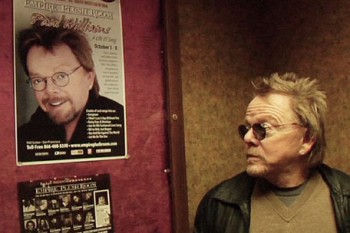 He then makes it clear when and if the camera should be running. He lightly cajoles Mr. Kessler into giving him, Mr. Williams, moments alone with his wife, and the film gets to be funny at the director’s expense. The film takes a very pleasant shape and finally comes solidly together during a concert tour of the Philippines, where Stephen Kessler is terrified that there are terrorists around every bend and their lives are in jeopardy. A bonding happens between the star and the director, and the film really takes hold. The intelligence of Paul Williams definitely comes through and shapes this documentary for Mr. Kessler, and the movie gives us a lot to care about. At almost every turn the treacly ideas of Mr. Kessler are often squelched by the good taste of Mr. Williams. At the point of the big climax, toward the end, Mr. Kessler proposes they sit down and watch some of the tv moments of the past for Mr.Williams. The idea being to watch Paul Williams squirm at some druggy moment cohosing the Merv Griffin Show. Finally, they do get to it, and Mr. Williams walks out on it. doing so shapes the climax and gives the film what it wants without any squirmy moments. It’s a good finale for the film, and gives Paul Williams all the dignity he deserves and gives the film the high point Stephen Kessler is searching for.
He then makes it clear when and if the camera should be running. He lightly cajoles Mr. Kessler into giving him, Mr. Williams, moments alone with his wife, and the film gets to be funny at the director’s expense. The film takes a very pleasant shape and finally comes solidly together during a concert tour of the Philippines, where Stephen Kessler is terrified that there are terrorists around every bend and their lives are in jeopardy. A bonding happens between the star and the director, and the film really takes hold. The intelligence of Paul Williams definitely comes through and shapes this documentary for Mr. Kessler, and the movie gives us a lot to care about. At almost every turn the treacly ideas of Mr. Kessler are often squelched by the good taste of Mr. Williams. At the point of the big climax, toward the end, Mr. Kessler proposes they sit down and watch some of the tv moments of the past for Mr.Williams. The idea being to watch Paul Williams squirm at some druggy moment cohosing the Merv Griffin Show. Finally, they do get to it, and Mr. Williams walks out on it. doing so shapes the climax and gives the film what it wants without any squirmy moments. It’s a good finale for the film, and gives Paul Williams all the dignity he deserves and gives the film the high point Stephen Kessler is searching for.
I also have to say that the editor, David Zieff, knew enough to follow the guide posts and let the film seem to fall together naturally. You know this doesn’t just happen, and it takes a good editor to make it work in a documentary such as this.
It’s a very good film, with a broad view of Mr. Williams’ career and a strong view of how his life has changed and ripened, post-rehabilitation. It just about concludes with Mr. Williams becoming ASCAP’s president with a mission to help protect the music rights of a lot of younger composers.
After the screening, they did have that wine and cheese event, and I recognized several people who I talked with, and some minor celebrities (Richard Kind) who I didn’t talk with. As I was leaving I passed Paul Williams and director Stephen Kessler, and I was tempted to say something. But I didn’t. The film answered any question I’d had, and I am too shy to just nose in on a celebrity and take up their time. Though I suppose that’s the purpose of such an event.
Actually, the film didn’t answer one question I had. Back in the very early 70s, I wrote to Paul Williams (care of his record company) seeking rights to a song he recorded called Lucky Old Sun. I thought it’d make a great animated short and wanted to find out what to do to get the rights. Of course, I never heard back from him and assume that he never got my letter. After all, it probably felt more like a fan letter than anything else. Even I wasn’t naive enough to believe it’d get to the right channels.
Frame Grabs &Hubley &UPA 21 May 2012 05:15 am
Rooty Toot Toot
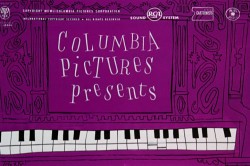 - As you know, I like this cartoon. Rooty Toot Toot. I think it’s one of the very best animated films ever made. The film combines brilliant design, with great animation, and an extraordinary story.
- As you know, I like this cartoon. Rooty Toot Toot. I think it’s one of the very best animated films ever made. The film combines brilliant design, with great animation, and an extraordinary story.
Kurosawa had directed Roshomon in 1950, and it had just touched down in the US. This tells of several people who meet up while waiting out a rain storm as they tell their differing versions of the killing of a samurai. It 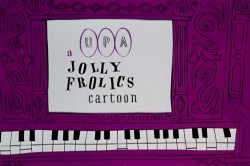 takes place in 12th Century Japan. There is no doubt that Hubley saw this film and does his cartoon adaptation of Frankie & Johnny using the same schema. It was not only daring for animation, but it was daring for film. It took the hands and eyes of a master to pull it off, and Hubley succeeded in the short 8 min cartoon.
takes place in 12th Century Japan. There is no doubt that Hubley saw this film and does his cartoon adaptation of Frankie & Johnny using the same schema. It was not only daring for animation, but it was daring for film. It took the hands and eyes of a master to pull it off, and Hubley succeeded in the short 8 min cartoon.
There is the legend that Steve Bosustow tried to get Hubley to speed up the
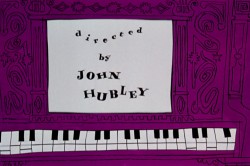 storyboard/writing process where finally the director had to lock himself and the board in to keep the production on hold until he thought it was finished. Eventually, according to the story, Bosustow broke down the door and put the film into its next phase. I don’t know what truth is in this, but I assume there must be a little something to it.
storyboard/writing process where finally the director had to lock himself and the board in to keep the production on hold until he thought it was finished. Eventually, according to the story, Bosustow broke down the door and put the film into its next phase. I don’t know what truth is in this, but I assume there must be a little something to it.
Unlike most other UPA films, this movie was made for an adult audience and it had no
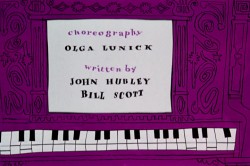 children to speak down to. Unlike most other UPA films, the art style came from 20th century art, not “illustration.” The inspiration was more Steinberg, Ben Shahn and WPA than Vanity Fair or the New Yorker.
children to speak down to. Unlike most other UPA films, the art style came from 20th century art, not “illustration.” The inspiration was more Steinberg, Ben Shahn and WPA than Vanity Fair or the New Yorker.
I’ve decided to pull frame grabs from the film, but that can only account for some still graphics. You really have to see this in motion, and I suggest you watch the version on the TCM Jolly Frolics DVD. It’s the only version that has a good transfer which does the design justice.
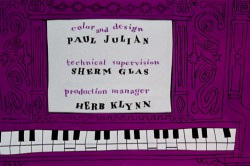
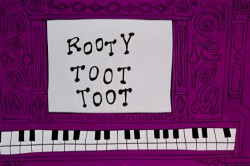
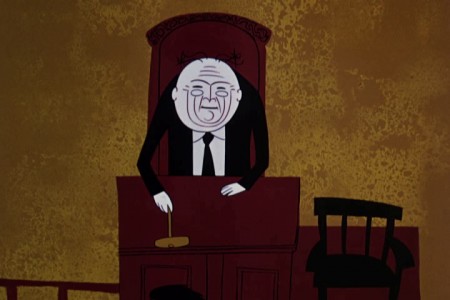 2
2
Gold colors dominate the opening of the trial,
except for Frankie’s bright red dress.

Frankie appears, to stand trial.
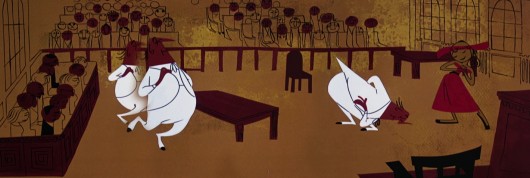
The defense does a dance with Frankie
as he caresses his client.
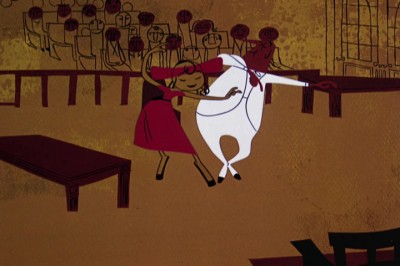 6
6
Choreographer Olga Lunick earned her money on this scene.
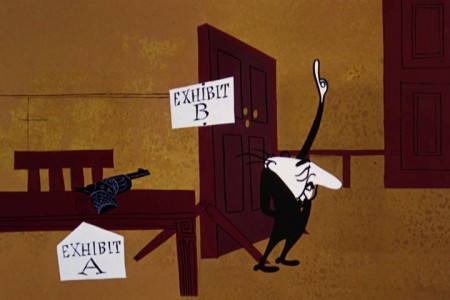 10
10
An open and shut kind of case.

The bartender is the first witness.
He waves hello to half those seated,
before raising his right hand to be sworn in.
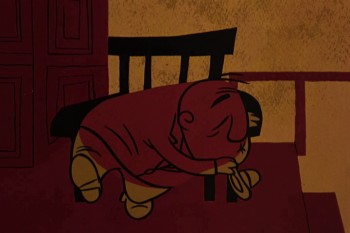 12
12
The bartender brings a subtle color change as
we move from gold hues to brownish colors.
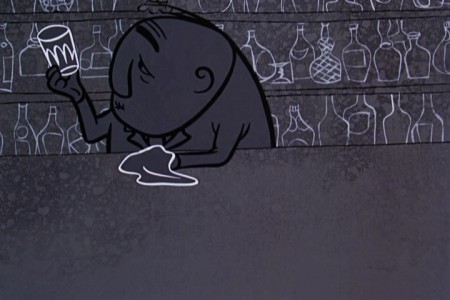 16
16
Once we go back to the bar, bluish grays take the scenes.
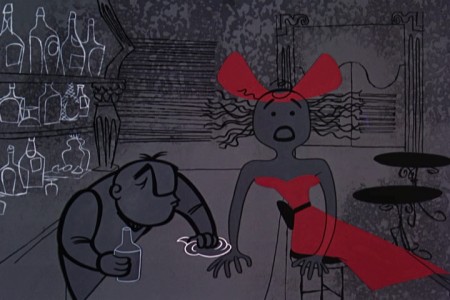 20
20
The bartender revealing Nellie Bly in the back room
foreshadows his reveal at the end of the film.
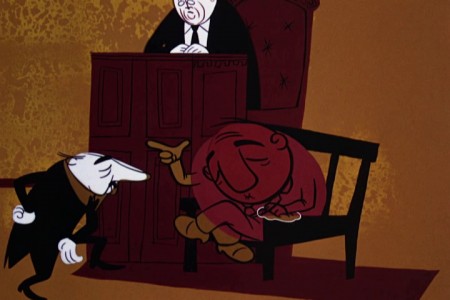 24
24
Back to the browns and ochres in the courtroom.
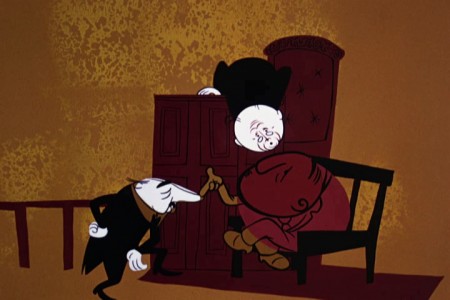 25
25
“Right in the snoot . . . ”
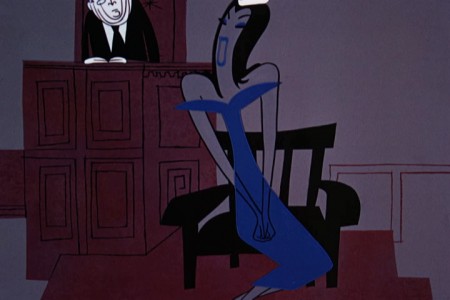 27
27
Nellie Bly brings her violets, lavenders and blues.
The exact opposite of Frankie’s colors.
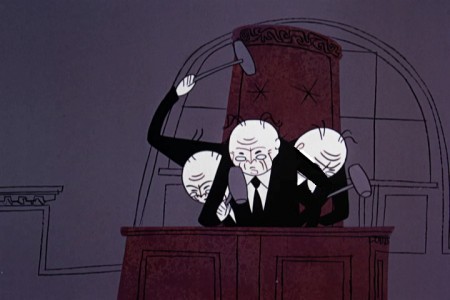 29
29
Order in the court.
The judge doesn’t smear; he breaks into multiple versions
of himself frenetically hammering his desk.
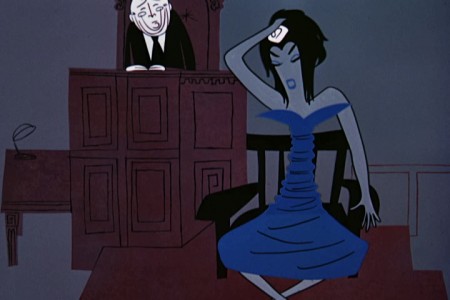 33
33
Straightening out the story . . .
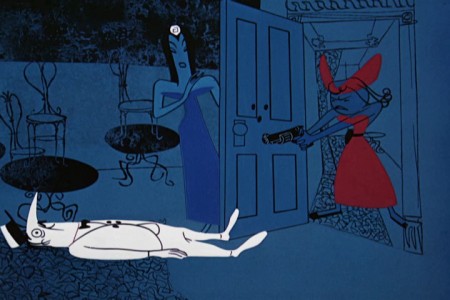 45
45
All blues except for that dress.
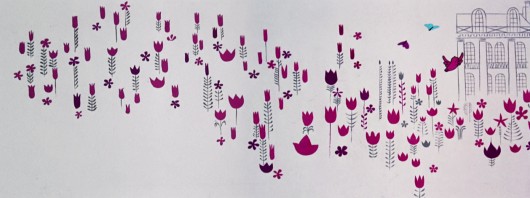
Frankie’s story comes in lily whites and white on white.
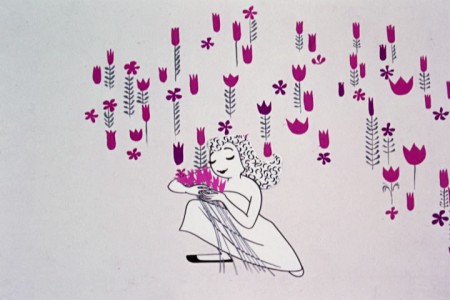 55
55
Her hair in this sequence was matted into the animation.
The decorative pattern didn’t move within the body of the hair.
A real pain in the butt for a design technique. Multiple camera runs.
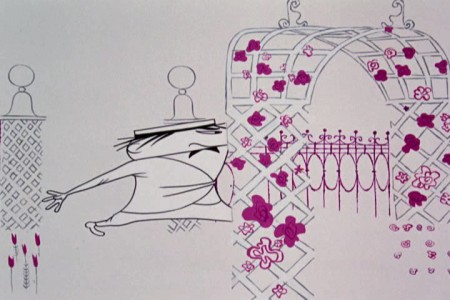 57
57
Smear frames are used in this sequnce for Johnny.
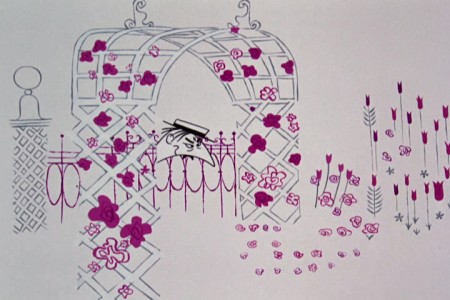 58
58
the victim is made to be the evil one.
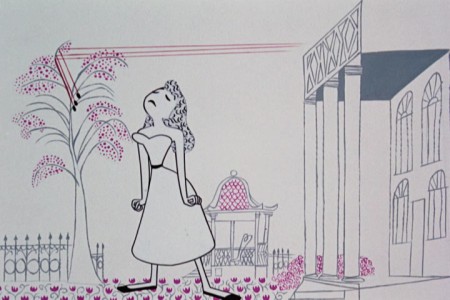 67
67
The bullets ricochet, musically, all over the place.
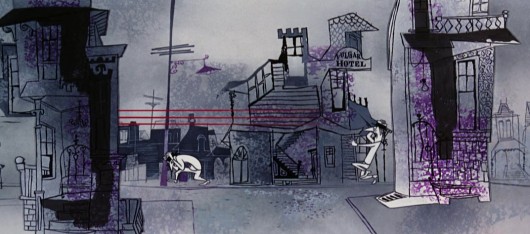
The pure whitish backgrounds turn to dirty grays.
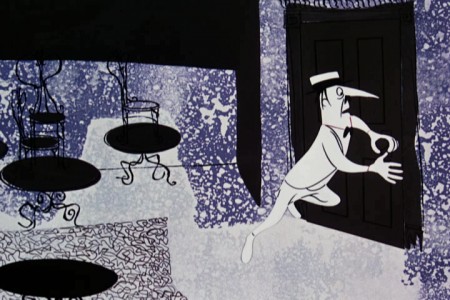 78
78
There’s a reuse of the gag as he looks out the door (see #40 on),
but the animation is different. No expense spared on this film.
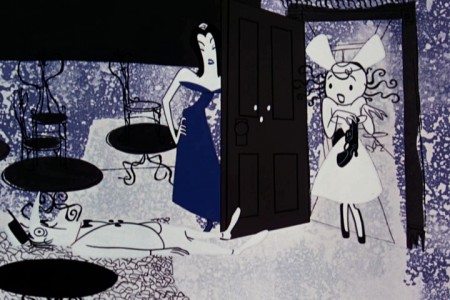 88
88
Back to the courtroom, vermillion is the color dominating.
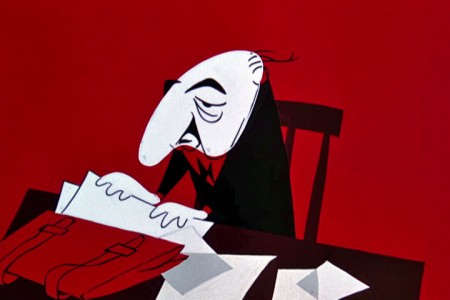 97
97
Back to the courtroom, vermillions turn to
deep reds as the innocent verdict is revealed.
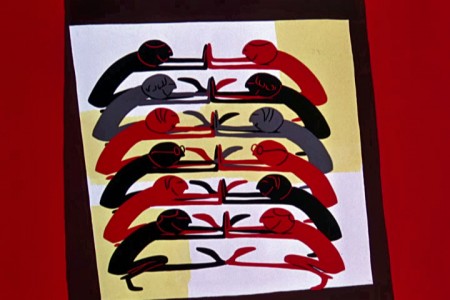 103
103
Very short quick scenes scream at the audience.
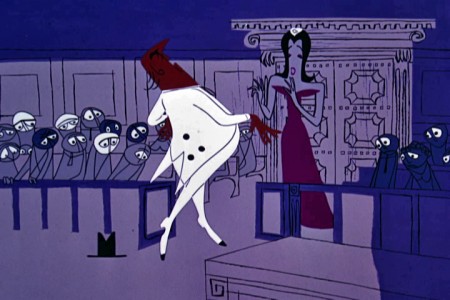 108
108
The attorney’s murder brings bright violets and lavenders.
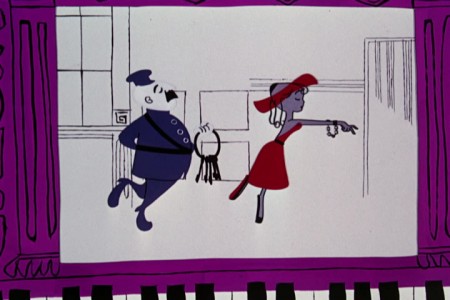 116
116
The lavenders dominate until we pull out
on the purple player piano.
This film, like Nordshtein’s Tale of Tales, is proof that animation can and should be as sophisticated as live action and as adult as any film. This is most certainly one of the classics in animation history. It’s only the animators and producers that hold the medium back.
Animation Artifacts &Bill Peckmann &commercial animation &Illustration 01 May 2012 07:26 am
Kimmelman Studio Gags
- Bill Peckmann sent the following drawings, and I’ll leave them to him to explain them:
- In the 1980′s, studio gags were a great way to chase away the daily dose of blues from working on a few of the more tedious TV spots that we did. Nobody had a better time of this, than assistant animator Mike Baez and myself at KCMP Studios. Not quite sure why I saved mine but I did and here they are. The gags of course have a “you had to be there” or an “in” feeling to them, so I’ll drop in a few captions to help.
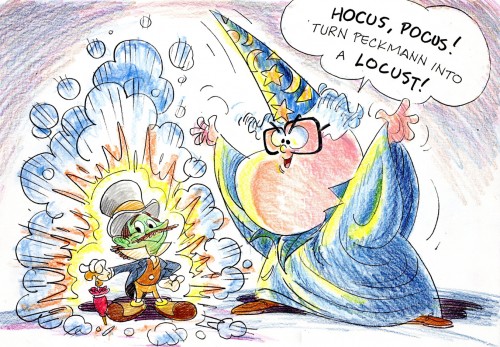 1
1“The magic of animation even works when you’re shticking around.” .
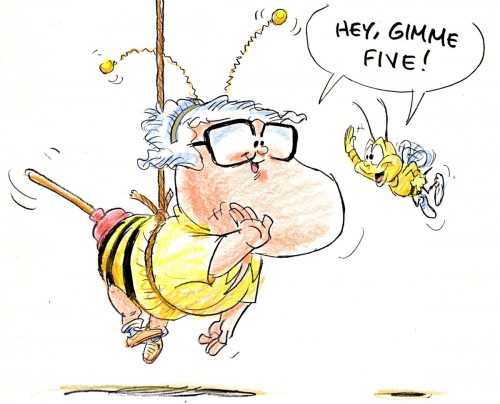 2
2“Congratulations on a commercial well done!” .
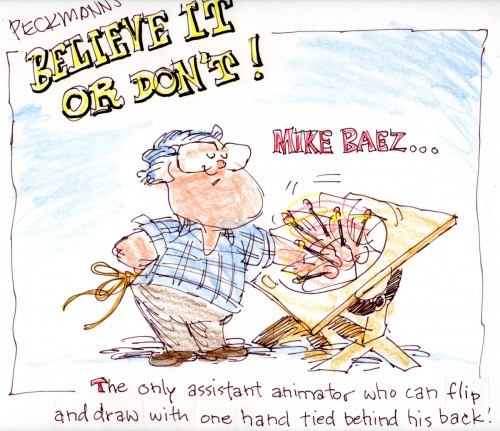 3
3“Mike Baez was always one of the best… ” .
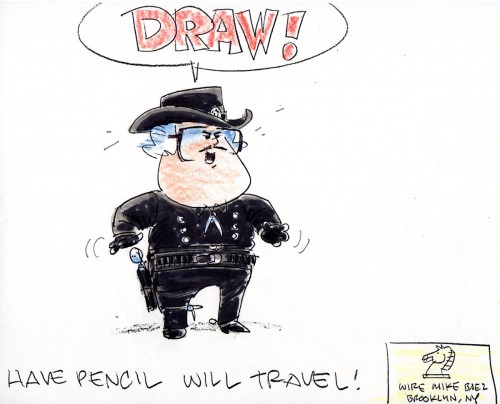 4
4” …and the fastest… ” .
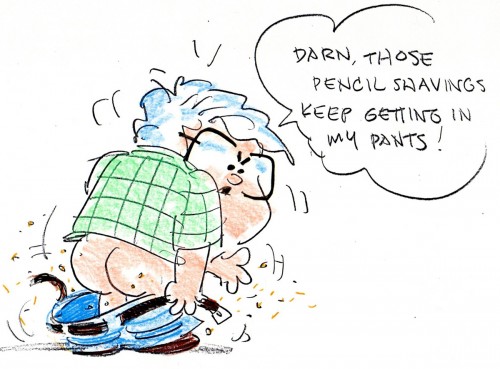 5
5” …and went through 2 boxes of Blackwings in a day!” .
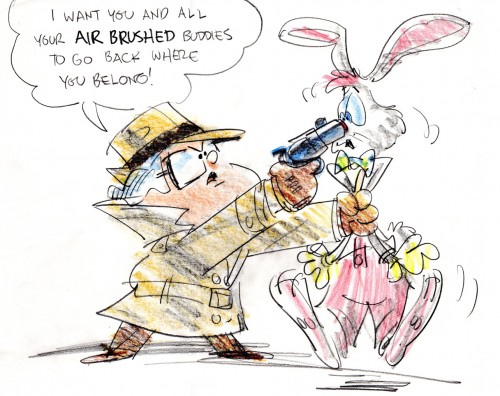 6
6“Adv. clients always loved to add feature film effects to their commercials.” .
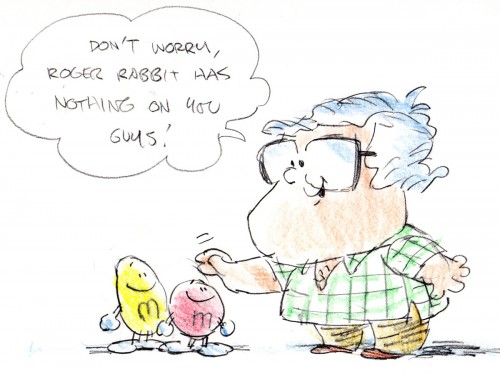 7
7“M&M’s with one of their first shots at shading.” .
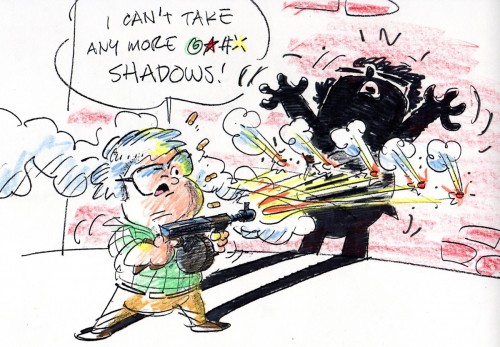 8
8“Doing accurate cast shadows always meant twice the amount of work!” .
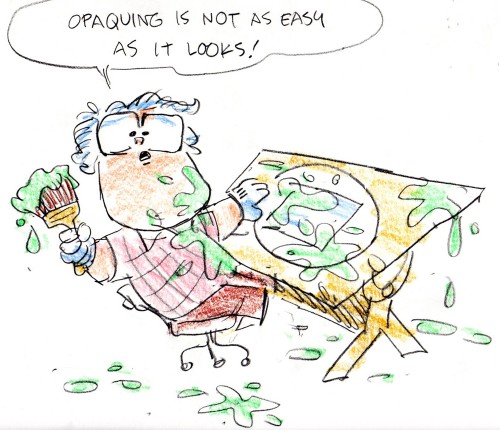 9
9“Always there to help out in a pinch… ” .
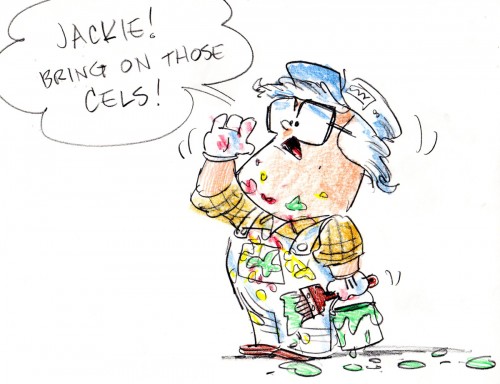 10
10” …and then some.” .
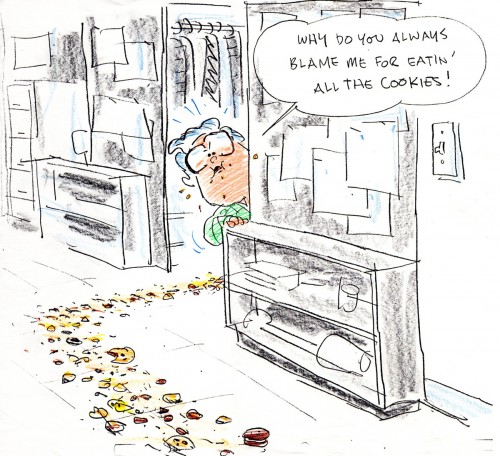 11
11“What was a studio if it didn’t have a cookie jar on the receptionist’s desk.” .
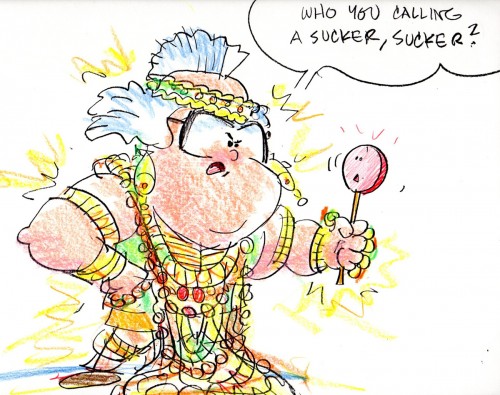 12
12“Or a candy jar on the front desk.” .
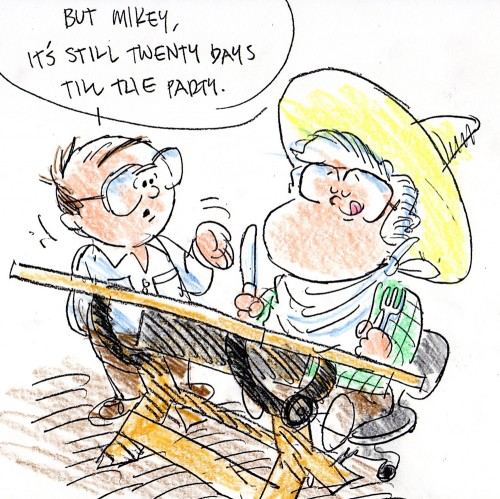 13
13“Eating, one of any studios beloved pastime, especially the
annual Christmas party at our favorite Mexican restaurant.” .
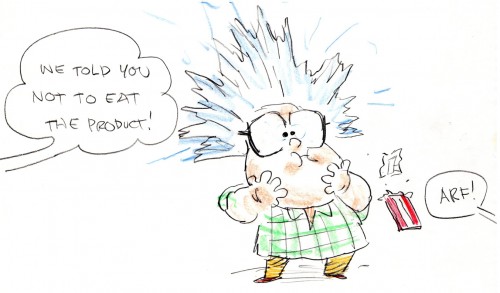 14
14“Who didn’t look forward to the client dropping off their
food product when we were working on their commercial.” .
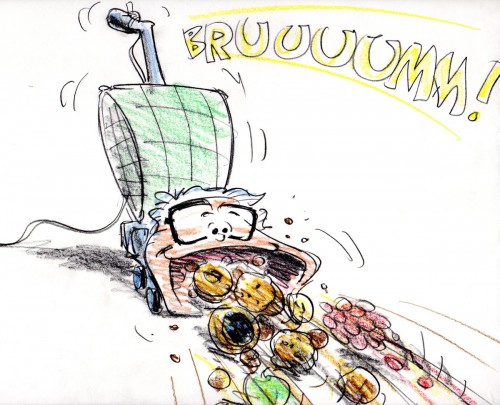 15
15“Those clients dropped off a lot of product, and when they did… ” .
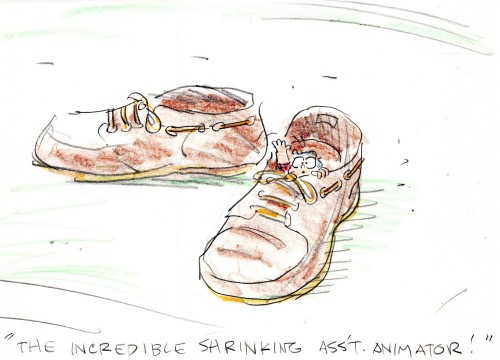 16
16” …we definitely had to look into a diet plan!” .
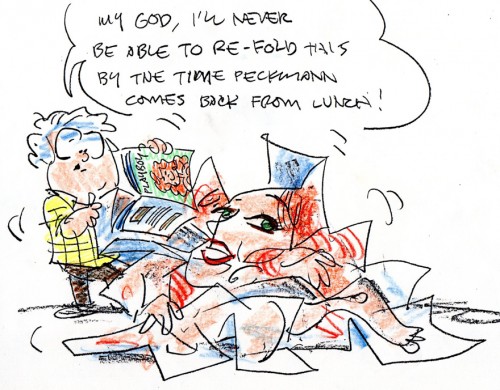 17
17“Lunch hour reading.” .
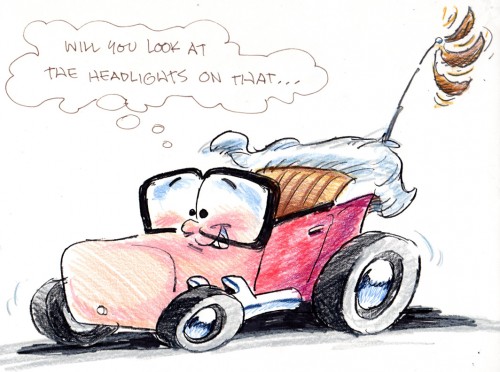 18
18“20 years before ‘Cars’” .
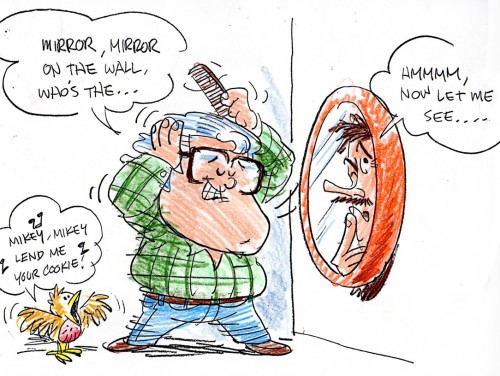 19
19“Reflections.” .
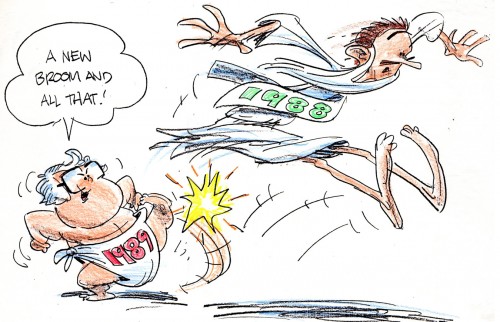 20
20“Those halcyon years at K.C.M.P. Studios, you don’t know what you got till it’s gone.” .
 21
21“All work and no play . . . ” .
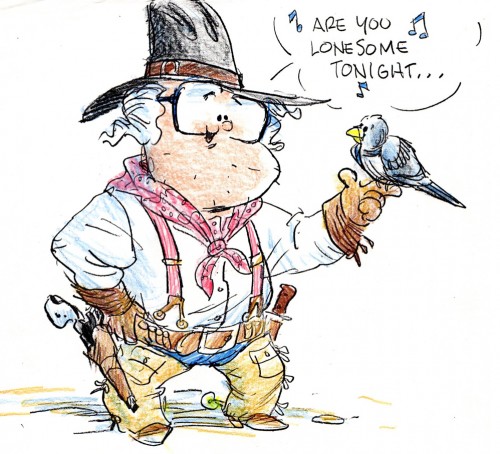 22
22“The day after watching your favorite TV series.” .
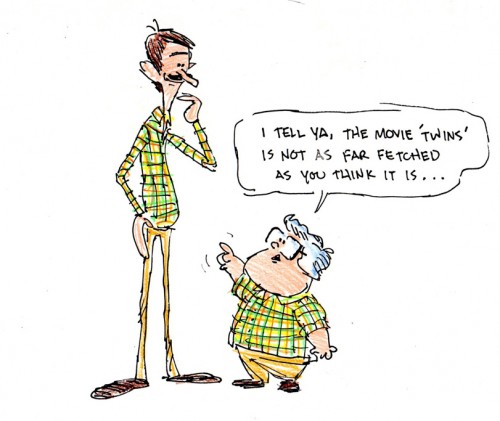 23
23“With apologies to Arnold S. and Danny D . .” .
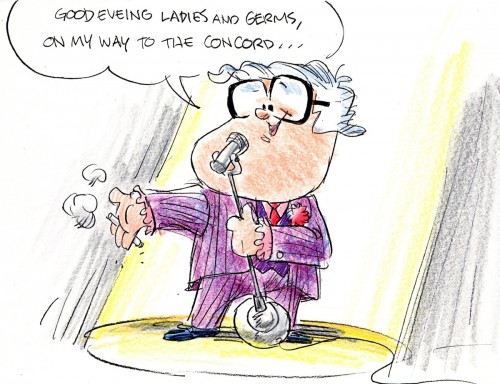 24
24“Dreams of a back up, second career.” .
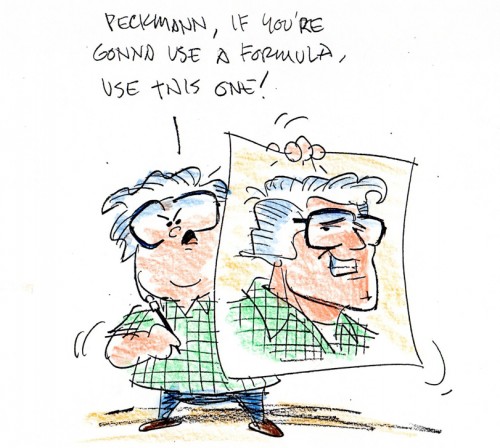 25
25“To the one and only Mike Baez who made working fun!” ______________________
Indiegogo
And now the promotion. The POE Project is up and running at INDIEGOGO, where there is a new page seeking contributions (however small) in support of a feature animated film I’m seeking to produce. The film has seen preproduction grow and the film start to blossom under the many thumbs of those who’ve worked on it. The script, the preparatory drawings, the storyboards and animatics (video story reels) and the great early voice over recordings all show us how promising a film this will be. We’re seeking some money to finalize a couple of minutes of the film to show investors what we’d like to see with the finished film.
Please visit our Indiegogo site.
Photos 15 Apr 2012 04:13 am
Steve Fisher “Manhattan Views”
Here are some Manhattan views as photographed by Steve Fisher.
 1
1
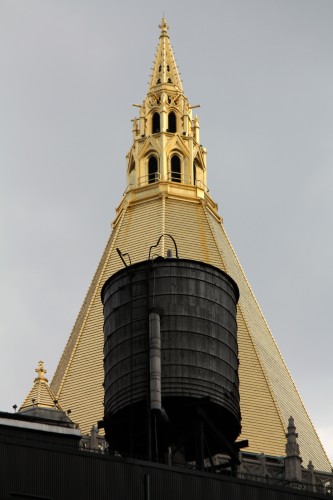 3
3
Photos 3-11 are of The Church of the Heavenly Rest.
Steve went there for an illustrated lecture given by David Lowe
on Art Deco in NY, sponsored by the New York Landmarks Conservancy.
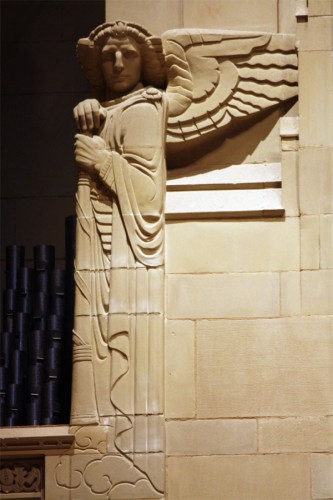 4
4
The Church of the Heavenly Rest and its adjoining Parish House
are in a Gothic Revival style melding into Art Deco.
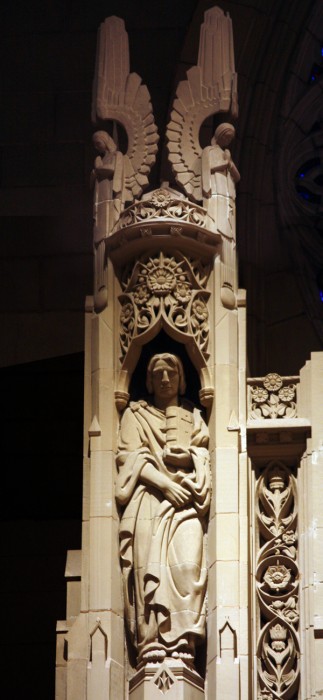 6
6
The Fifth Avenue façade features sculpture
by the renowned artist Lee Lawrie.
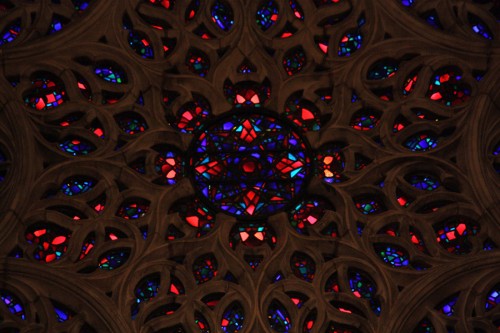 7
7
The church was built on land purchased by Andrew Carnegie in 1917 . . .
 8
8
. . . to prevent the construction of a tall building on the site
which would have cast a shadow . . .
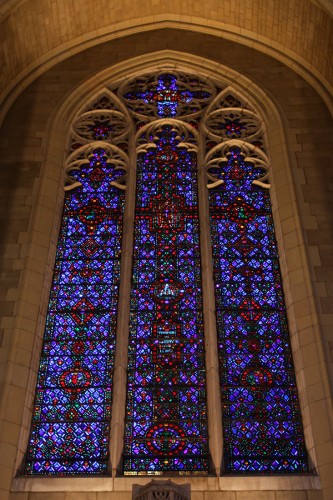 9
9
. . . on the adjacent Carnegie mansion and garden.
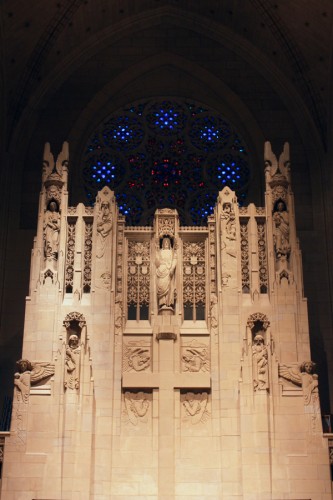 10
10
The Indiana limestone clad buildings were constructed
in 1927-29 by Mayers, Murray & Phillip.
Daily post 23 Mar 2012 11:00 am
Alice’s Shadows – Re-post
- An interesting aspect of Disney’s Alice In Wonderland, deserves some attention, and I don’t think I’ve ever seen anyone write about it.
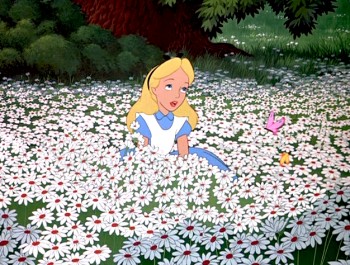 Once Alice is in Wonderland, she immediately comes upon the woods, and from there she steps in and out of the woods to meet up with new crazies and her peculiar adventures. The effects department was used to signal this move in and out of the dark world of wonderland. She constantly steps in and out of shadows.
Once Alice is in Wonderland, she immediately comes upon the woods, and from there she steps in and out of the woods to meet up with new crazies and her peculiar adventures. The effects department was used to signal this move in and out of the dark world of wonderland. She constantly steps in and out of shadows.
This, as anyone who did animation in the pre-computer age, knows that it was a complication to add shadows. Not only the shadows under the characters but the shadows over and around the characters. It meant filming the scenes twice, just for the shadows. Since the camera, during the filming of Alice, was not computerized this double shooting had to be done by hand VERY CAREFULLY. Every frame had to exactly match.
Hence, this was an important part of the design. The directors and Disney took these shadows seriously; after all they cost twice as much – just to photograph. Never mind animating them, coloring them or planning them.
I’ve put together a number of frame grabs which illustrate the move into or out of shadows, and I’d like to share them.
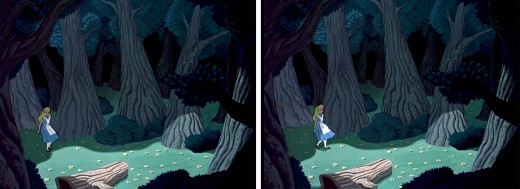
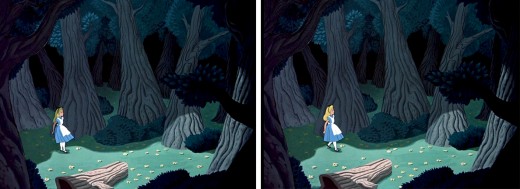
Here, Alice steps out of a shadow for the first time, and meets up with
Tweedle Dee and Tweedle Dum. They’re partially covered, themselves, by shadow.
This variant of the shadow is a hard line of darkness that moves over her.
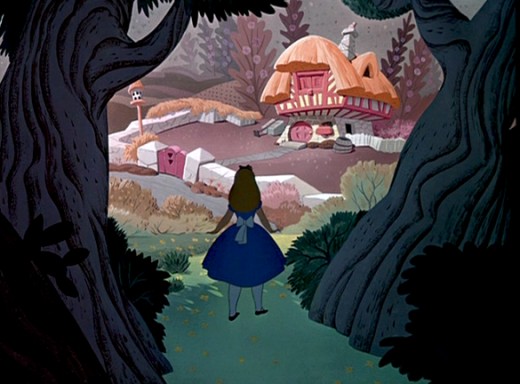
Soon, Alice moves toward the Duchess’ house. We cut from her
standing dark in shadow, to her walking in a brighter light.
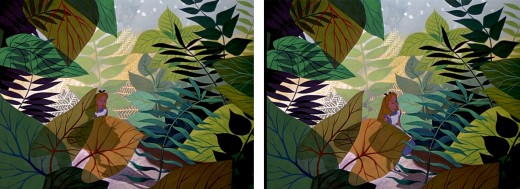
As she moves toward the Caterpillar, Alice is covered with shrubbery and shadow.
She is next seen struggling through the foliage to talk to the Caterpillar, in full light.
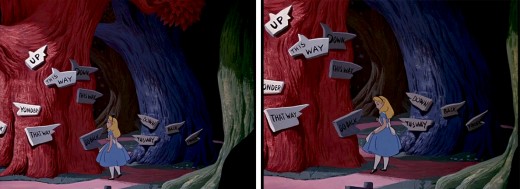
This variant of the shadow is a total shift in color as her entire body moves into darkness.
It was done by dissolving one Alice into another – meaning the cels were painted twice.
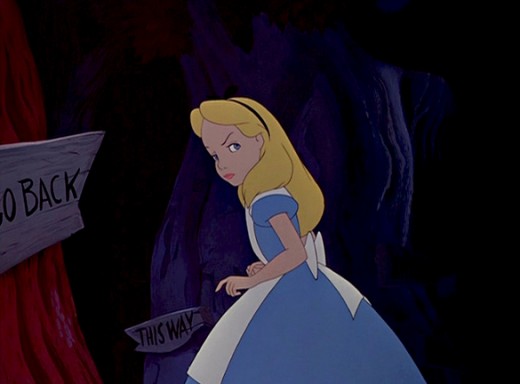
In the woods, Alice walks into and out of and into shadows.
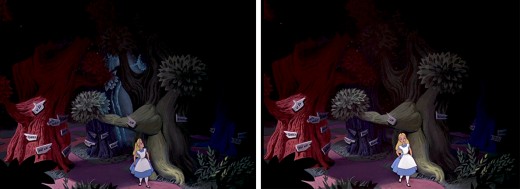
She slowly moves toward the Cheshire Cat who directs her to the tea party.
As she does she moves from shadow and cuts into light as she appears at the gate.
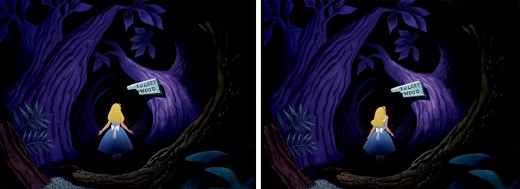
This is a particularly nice effect wherein the entire area gets spotlighted -
led by the character. The area outside of the spot darkens slowly and beautifully.
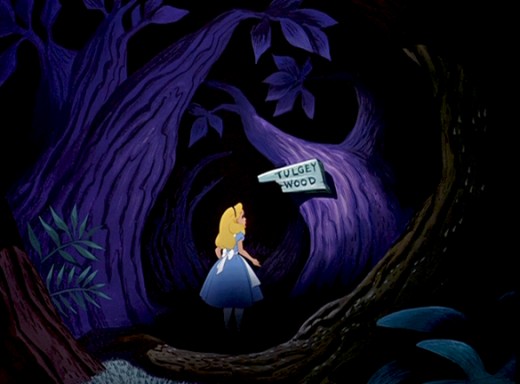
Once leaving the tea party, she wanders around the Tulgey Wood trying to find any direction. Shadows aplenty as she moves endlessly through the woods.
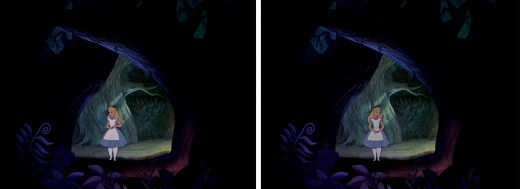
Alice moves into and out of shadow via dissolves.
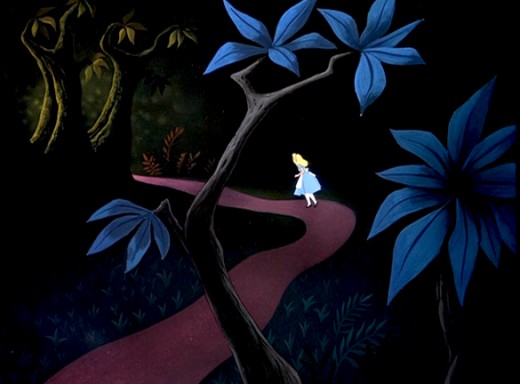
Alice passes by many crazy characters, going in and out of darkness.
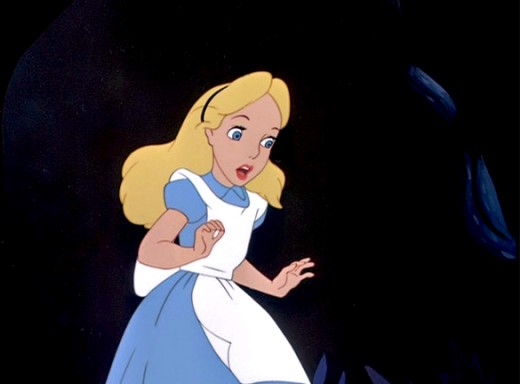
Just prior to meeting up with the Cheshire Cat, and has an extended conversation
which just about ends her stay in the woods.
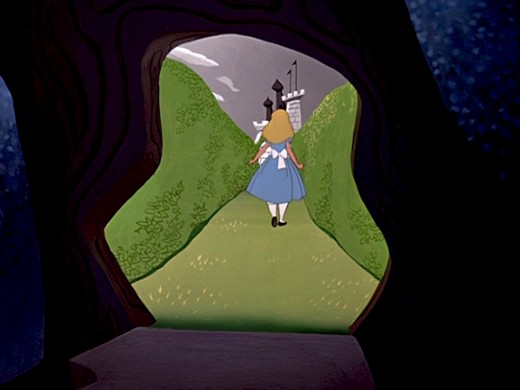
Finally, Alice steps into the Cheshire Cat’s tree and
into the light of the maze of cards to meet the Red Queen.
Daily post 18 Mar 2012 09:22 am
Kickstarter Redux
We’re still kicking, so to speak, in a Kickstarter sort of way. So, why am I passionate about POE? I read his stories and poems in high school and they made an indelible mark on my life as an artist. For me, the name Poe brings to mind images of murderers and madmen, premature burials, and bloody corpses walled within false chimneys. Just as the bizarre characters in Poe’s stories have captured my imagination, so too has Poe himself. Was he some morbid, mysterious figure lurking in the shadows of moonlit cemeteries or crumbling castles? Or is this the Poe of legend? I think that this fascination with Edgar Allan Poe, the legend and the man behind the legend, extends far beyond my own personal and artistic interest. Poe’s life and stories would make a fantastic and fascinating animated feature and I think there is a large audience out there waiting for it. Please take the time to check out the Kickstarter page, and if you can contribute anything, thank you. If not, tell your friends. It’s the friends and the friends of friends who will help us move forward.
